Tradescantia, also known as Spiderwort or Wandering Jew, is a fascinating group of plants famous for their colorful foliage and easy-care nature. Whether you’re a beginner or an experienced gardener, these beauties can add a vibrant touch to your home. Let’s dive into these amazing Tradescantia varieties!
Contents
- 1 Tradescantia Zebrina
- 2 Tradescantia Zebrina ‘Violet Hill’
- 3 Tradescantia Zebrina ‘Discolor Multicolor’
- 4 Tradescantia Zebrina ‘HappiLee’
- 5 Tradescantia Zebrina ‘Pink Paradise’
- 6 Tradescantia Zebrina ‘Burgundy’
- 7 Tradescantia Zebrina ‘Quadricolor’
- 8 Tradescantia Zebrina ’Evanesce’
- 9 Tradescantia Zebrina ’Little Hill’
- 10 Tradescantia Zebrina ’Leprechaun’
- 11 Tradescantia Zebrina ’Silver Smudge’
- 12 Tradescantia Zebrina ‘Tikal’
- 13 Tradescantia Zebrina ‘Purple Plush’
- 14 Tradescantia Zebrina ‘Purpusii’
- 15 Tradescantia Zebrina ‘Flame Dance’
- 16 Tradescantia Cerinthoides
- 17 Tradescantia Cerinthoides ‘Red Hill’
- 18 Tradescantia Cerinthoides ‘Nanouk’
- 19 Tradescantia Cerinthoides ‘White Nanouk’
- 20 Tradescantia Cerinthoides ‘Green Nanouk’
- 21 Tradescantia Cerinthoides ‘Limelight’
- 22 Tradescantia Cerinthoides ‘Pink Furry’
- 23 Tradescantia Pallida
- 24 Tradescantia Pallida ‘Pink Stripe‘
- 25 Tradescantia Pallida ‘Blue Sue‘
- 26 Tradescantia Pallida ‘Shadow Hill‘
- 27 Tradescantia Pallida ‘Purple Pixie‘
- 28 Tradescantia Pallida ‘Kartuz Giant‘
- 29 Tradescantia Sillamontana
- 30 Tradescantia Sillamontana Variegata
- 31 Tradescantia Sillamontana ’Gold Stripes’
- 32 Tradescantia Fluminensis
- 33 Tradescantia Fluminensis Variegata
- 34 Tradescantia Fluminensis ‘Yellow Hill’
- 35 Tradescantia Fluminensis ‘Aurea’
- 36 Tradescantia Fluminensis ‘Albovittata’
- 37 Tradescantia Fluminensis ‘Tricolor’
- 38 Tradescantia Fluminensis ‘Lilac’
- 39 Tradescantia Spathacea
- 40 Tradescantia Spathacea ‘Tricolor’
- 41 Tradescantia Spathacea ‘Sitara’
- 42 Tradescantia Spathacea ‘Sitara Gold’
- 43 Tradescantia Spathacea ‘Concolor’
- 44 Tradescantia Spathacea ‘Vittata’
- 45 Tradescantia Chrysophylla
- 46 Tradescantia Chrysophylla Variegata
- 47 Tradescantia Blushing Bride
- 48 Tradescantia Mundula
- 49 Tradescantia Mundula ‘Variegata’
- 50 Tradescantia Mundula ‘Green Hill’
- 51 Tradescantia Mundula ‘Fairy Wings’
- 52 Tradescantia Mundula ‘Lisa’
- 53 Tradescantia Pink Dragon
- 54 Tradescantia ‘Angel Wings’
- 55 Tradescantia Roxxo
- 56 Tradescantia Hirta ‘Swifftale’
- 57 Tradescantia Unicorn
- 58 Tradescantia Tenderness
- 59 Tradescantia Brightness
- 60 Tradescantia Pale Puma
- 61 Tradescantia Sweetness
- 62 Tradescantia Sweet Tabby
- 63 Tradescantia Zanonia ‘Mexican Flag’
Tradescantia Zebrina
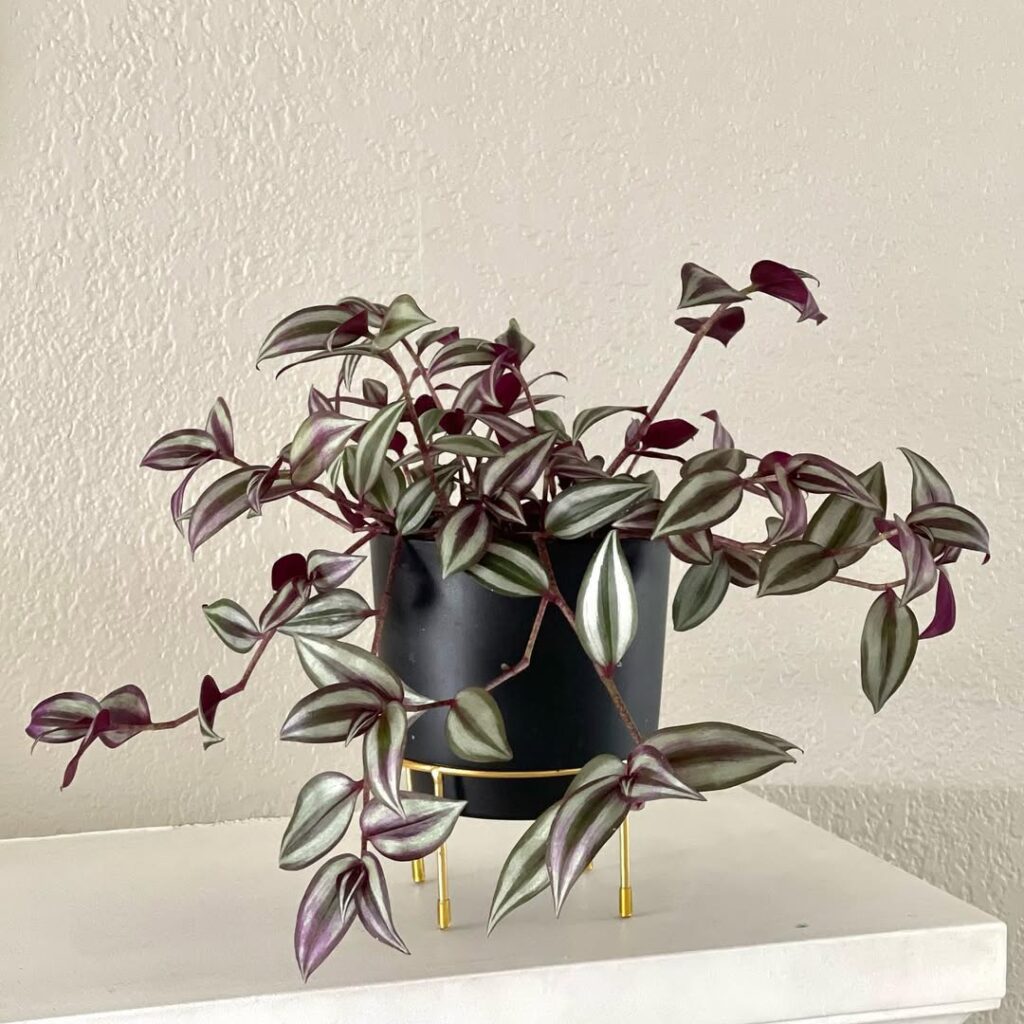
One of the most popular varieties, Tradescantia Zebrina boasts striking silver and purple-striped leaves. It thrives in bright, indirect light and makes an excellent trailing plant for hanging baskets.
Tradescantia Zebrina ‘Violet Hill’
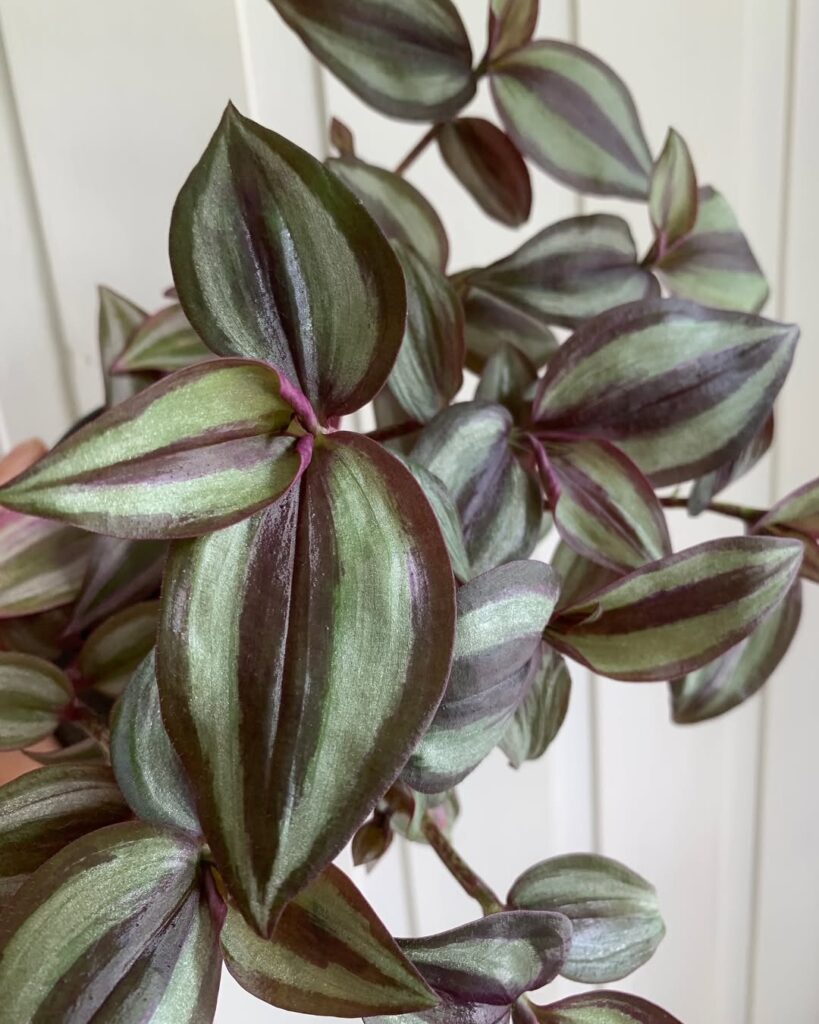
Tradescantia Zebrina ‘Violet Hill’ is one of the most common Zebrina varieties, known by names like Silver Plus, Pink Joy, Red Jewel, and Red Gem, and has been around for over 20 years. It is fascinating for its ability to change appearance based on conditions, affecting growth habit, leaf shape, size, and color. A key identifier is its slightly rough upper leaf surface with warty bumps and scattered hairs, which distinguish it from Minima, whose silver bands form a zigzag pattern instead. Though flowers are uncommon, when they appear, they showcase light purple petals typical of the species.
Tradescantia Zebrina ‘Discolor Multicolor’
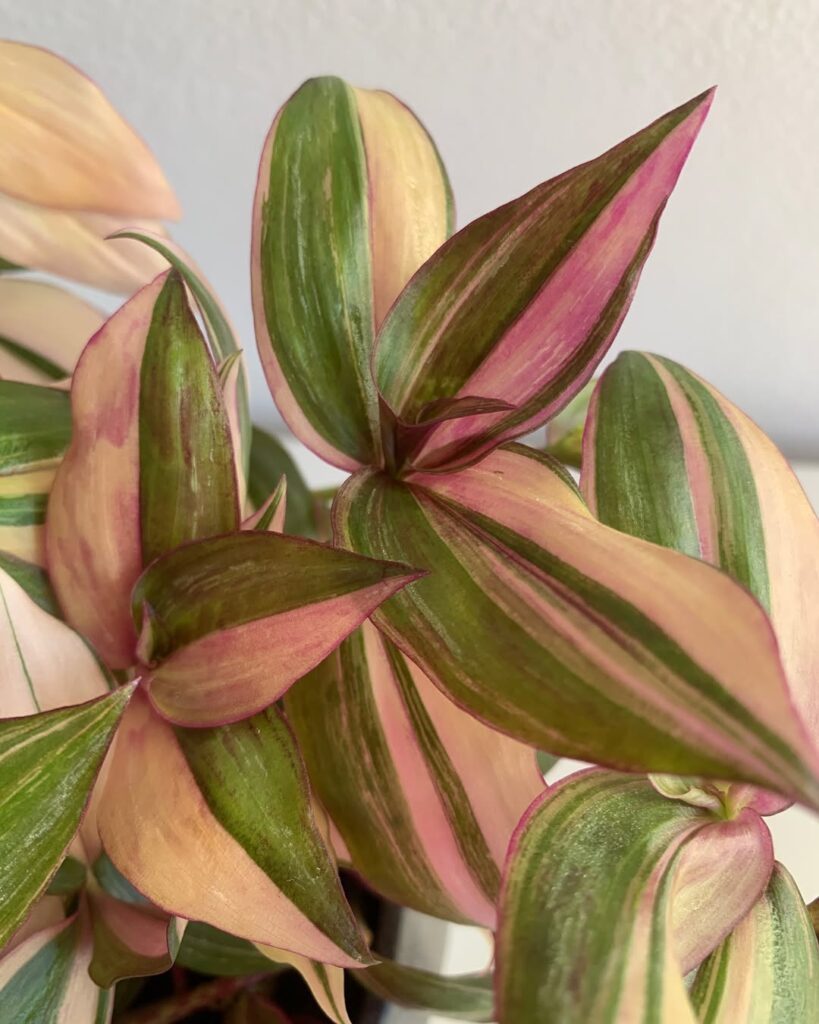
A stunning variegated cultivar, Tradescantia Zebrina ‘Discolor Multicolor’ is often confused with Happilee and Quadricolor, but it can be distinguished by its narrow, broken silver stripes—the thinnest among the three. Quadricolor has the widest silver bands, while Happilee features narrower stripes with a distinct notch. This variety’s appearance shifts significantly based on light exposure, making it a dynamic and ever-changing addition to any collection.
Tradescantia Zebrina ‘HappiLee’
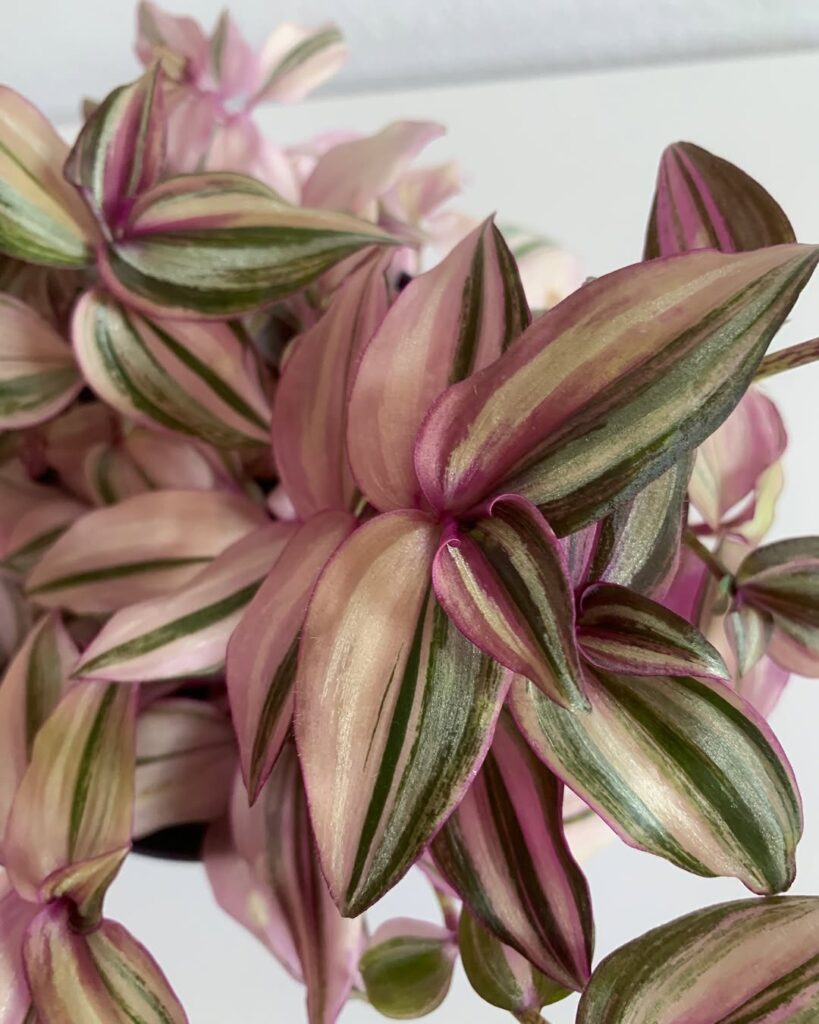
A stunning variegated cultivar, Tradescantia Zebrina ‘HappiLee’ belongs to the trio of variegated Zebrinas alongside Quadricolor and Discolor Multicolor, distinguished by its zigzag-patterned silver stripes—wider than Discolor Multicolor but narrower than Quadricolor. HappiLee grows more slowly than the other two and tends to develop thin, weak stems, but it retains its variegation exceptionally well, showcasing a lovely pink hue. Since HappiLee is a sport of Tradescantia Zebrina ‘Minima’, if it ever reverts, it will return to its Minima form.
Tradescantia Zebrina ‘Pink Paradise’
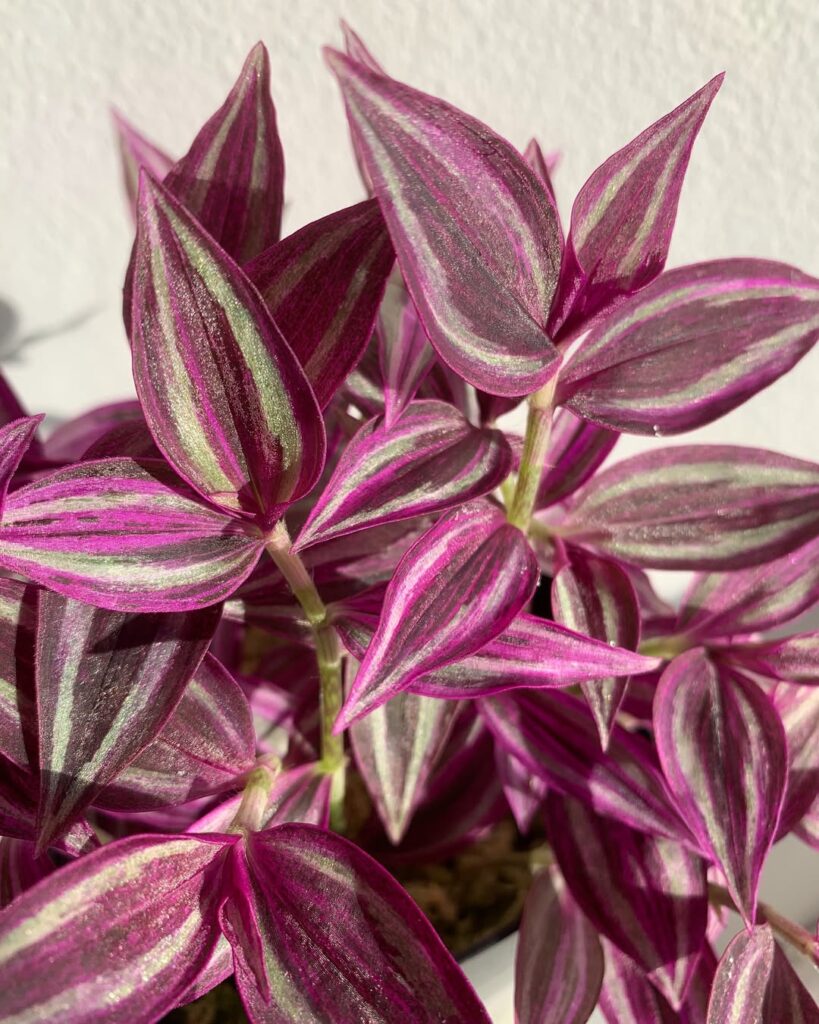
A captivating cultivar, Tradescantia Zebrina ‘Pink Paradise’ features pink leaves with classic Zebrina stripes, making it a favorite among plant enthusiasts. Its smaller leaves and thinner stems with shorter internodes set it apart from other Zebrinas, giving it a more delicate appearance. While it grows slower than most Tradescantias, its unique coloration makes it a standout addition to any collection.
Tradescantia Zebrina ‘Burgundy’
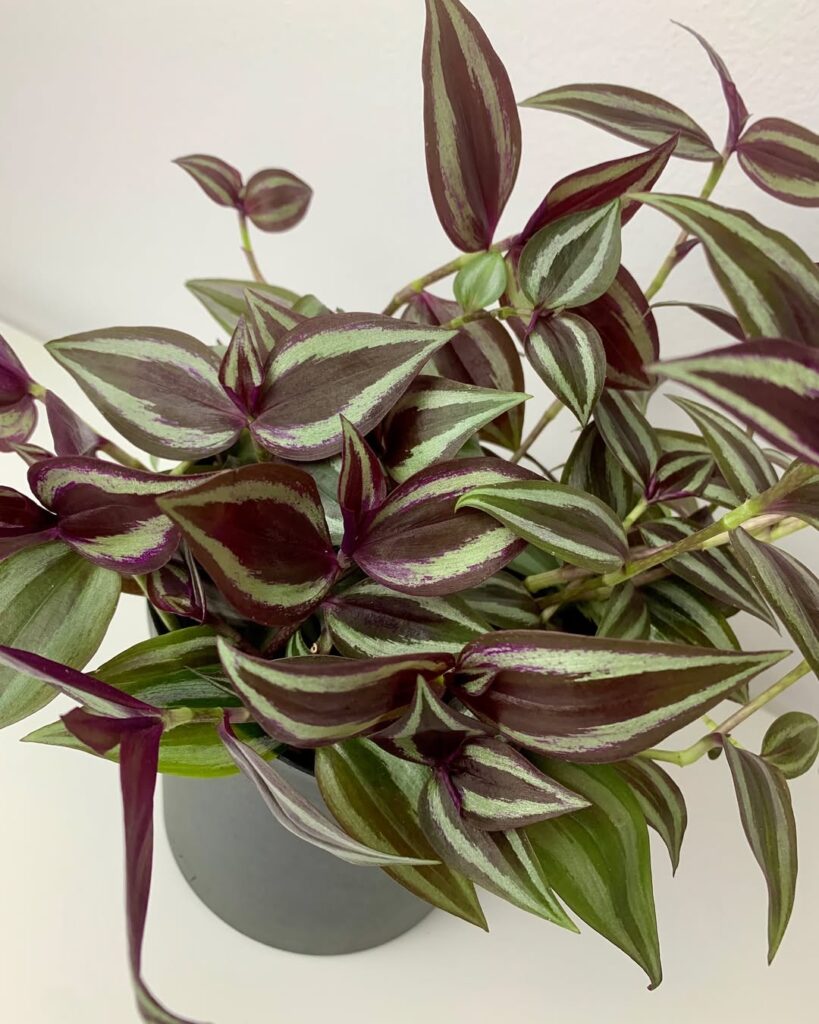
Tradescantia Zebrina ‘Burgundy’ is a stunning variety within the Zebrina species, sometimes mislabeled as Purple Joy, Red Gem, or Purple Passion, and widely available in plant shops worldwide. Its deep purple leaves with silvery streaks can shift in color depending on environmental conditions—bright light enhances its rich hues, while lower light may cause a slightly greener appearance, though never fully green. Unlike most Tradescantias, Burgundy flowers more frequently indoors, producing purple blooms with a white center, distinguishing it from its close relative, Deep Purple, whose flowers are fully purple without the white center.
Tradescantia Zebrina ‘Quadricolor’
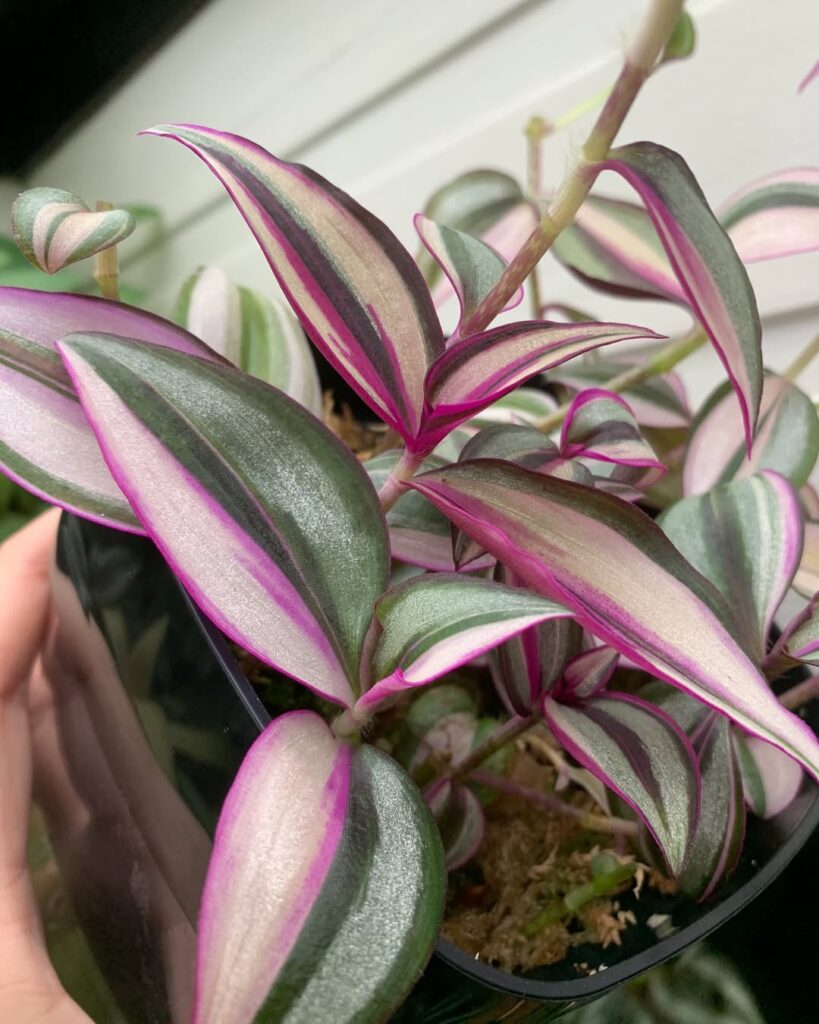
A breathtaking variegated cultivar, Tradescantia zebrina ‘Quadricolor’ showcases green, cream, pink, and white-striped leaves, creating a mesmerizing blend of colors. This trailing plant thrives in bright, indirect light and enjoys moderate watering, making it an excellent choice for hanging baskets or decorative pots. Its fast-growing nature allows it to quickly fill spaces with lush, cascading foliage.
Tradescantia Zebrina ’Evanesce’
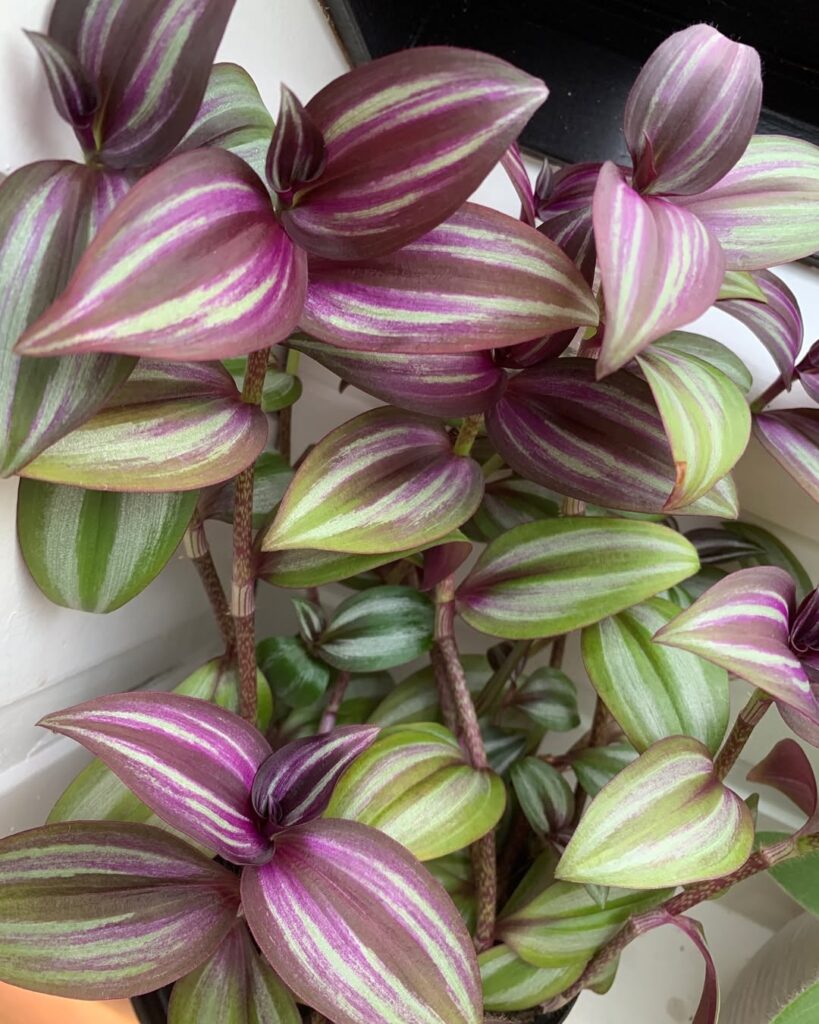
A newer but rapidly popular variety, Tradescantia Zebrina ‘Evanesce’ stands out with its silvery bands and striking purple stripes, complemented by a thicker stem and a more upright growth habit compared to other Zebrinas. Like most Tradescantias, it is easy to care for, but its vibrant purple stripes require careful light management—too little light can cause them to fade.
Tradescantia Zebrina ’Little Hill’
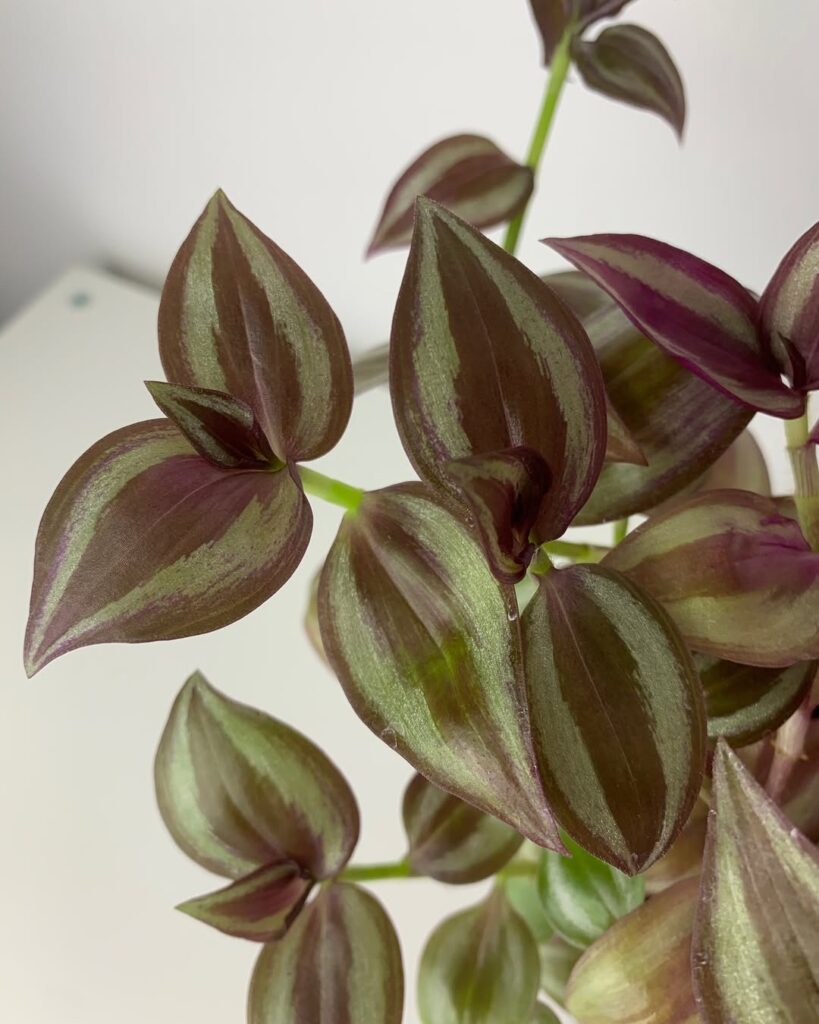
Often mislabeled as ‘Red Gem’ or ‘Dark Desire’, Tradescantia Zebrina ‘Little Hill’ produces small, charming purple flowers when it blooms. It can sometimes be mistaken for ‘Burgundy’ and ‘Deep Purple’, as their appearances shift under different lighting conditions. However, ‘Little Hill’ stands out with its slightly rounder leaf shape, making it a more reliable identifier than color alone, which varies significantly.
Tradescantia Zebrina ’Leprechaun’
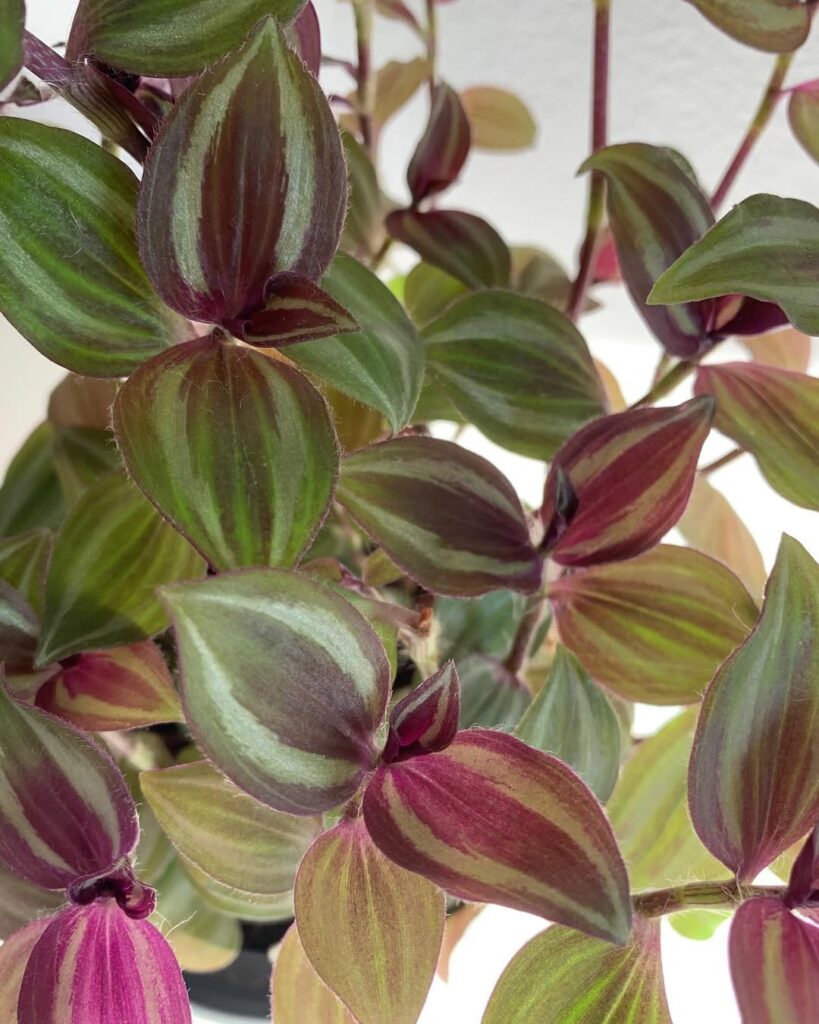
Believed to be a cross between Zebrina ‘Little Hill’ and ‘Purple Plush’, Tradescantia Zebrina ‘Leprechaun’ stands out with its slightly smaller leaves covered in long hairs, distinguishing it from Little Hill, which has hairless leaves, and Purple Plush, which lacks silver stripes. Its green, purple, and silver variegation creates a striking contrast, making it a unique addition to any collection.
Tradescantia Zebrina ’Silver Smudge’

A distinctive cultivar, Tradescantia Zebrina ‘Silver Smudge’ features a thinner silver stripe compared to Superba and lacks the tiny bumps seen on Violet Hill. Its silver marking has a slight zigzag pattern, similar to Minima, but its leaves are larger than Leprechaun. This variety is greener than Burgundy and, unlike Quadricolor, it has no variegation. It thrives in bright, indirect light and prefers moderate watering, making it a striking yet easy-care addition to any collection.
Tradescantia Zebrina ‘Tikal’
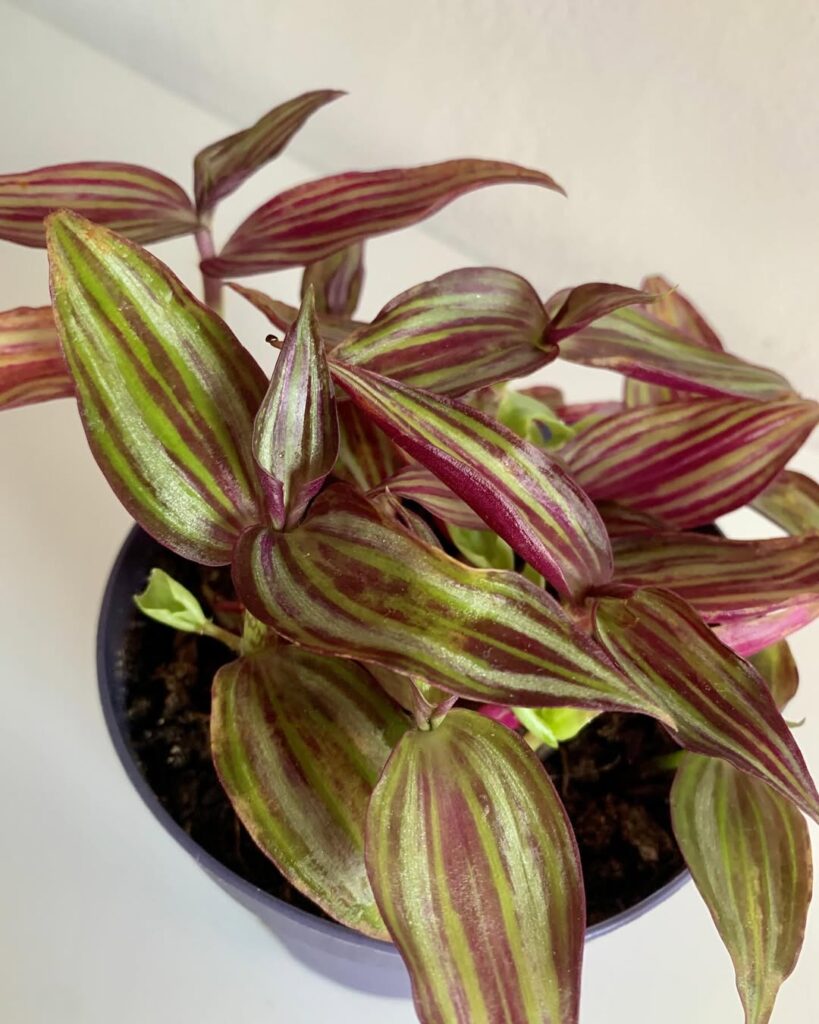
Tradescantia Zebrina ‘Tikal’ is named after its discovery site in Tikal, Guatemala and develops red pinstripes on its leaves in bright light. However, it has sparked debate due to its tendency for brown spots, curled leaves, and other stress signs, with virus tests coming back negative, leaving its issues unexplained—though they don’t seem to spread to other plants. It has thicker, stiffer leaves than other Zebrinas, and its growth can be slow, sometimes leading to frustration, but its unique foliage and pinstriping make it a fascinating addition to any collection.
Tradescantia Zebrina ‘Purple Plush’
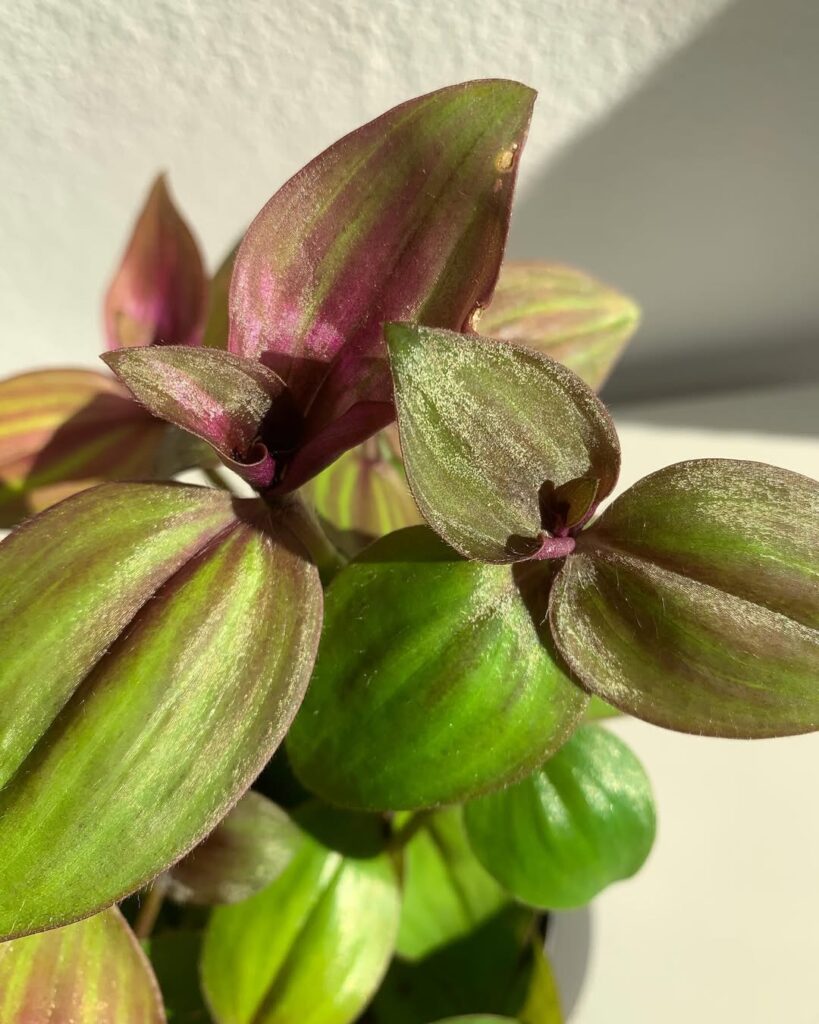
A unique member of the Zebrina species, Tradescantia Zebrina ‘Purple Plush’ lacks the classic silvery stripes found in most Zebrinas. Instead, under bright light, it develops stunning red pinstripes, adding to its distinct appearance. Its textured, hairy leaf surface further sets it apart, creating a velvety effect. When it blooms, it produces small purple flowers, typical of the species.
Tradescantia Zebrina ‘Purpusii’
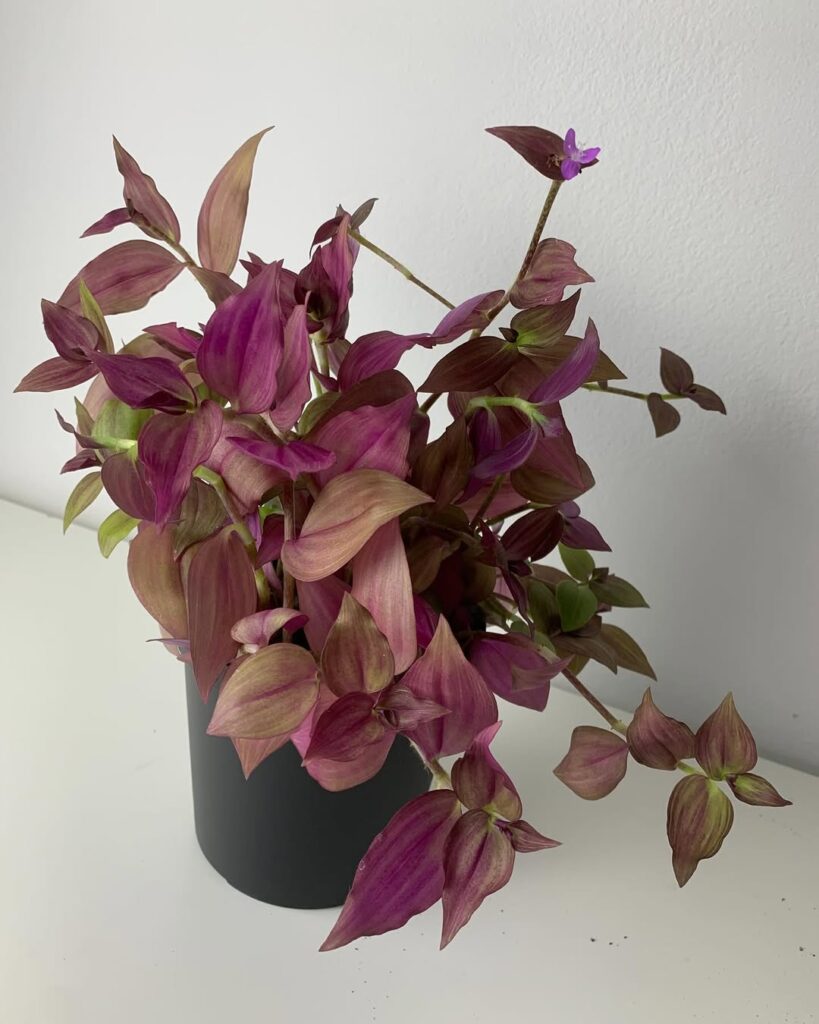
Unlike most Zebrinas, Tradescantia Zebrina ‘Purpusii’ lacks silvery stripes, instead featuring dark green leaves that can develop a reddish tint under strong light. This variety blooms with small purple flowers, typical of the Zebrina species, adding to its charm.
Tradescantia Zebrina ‘Flame Dance’
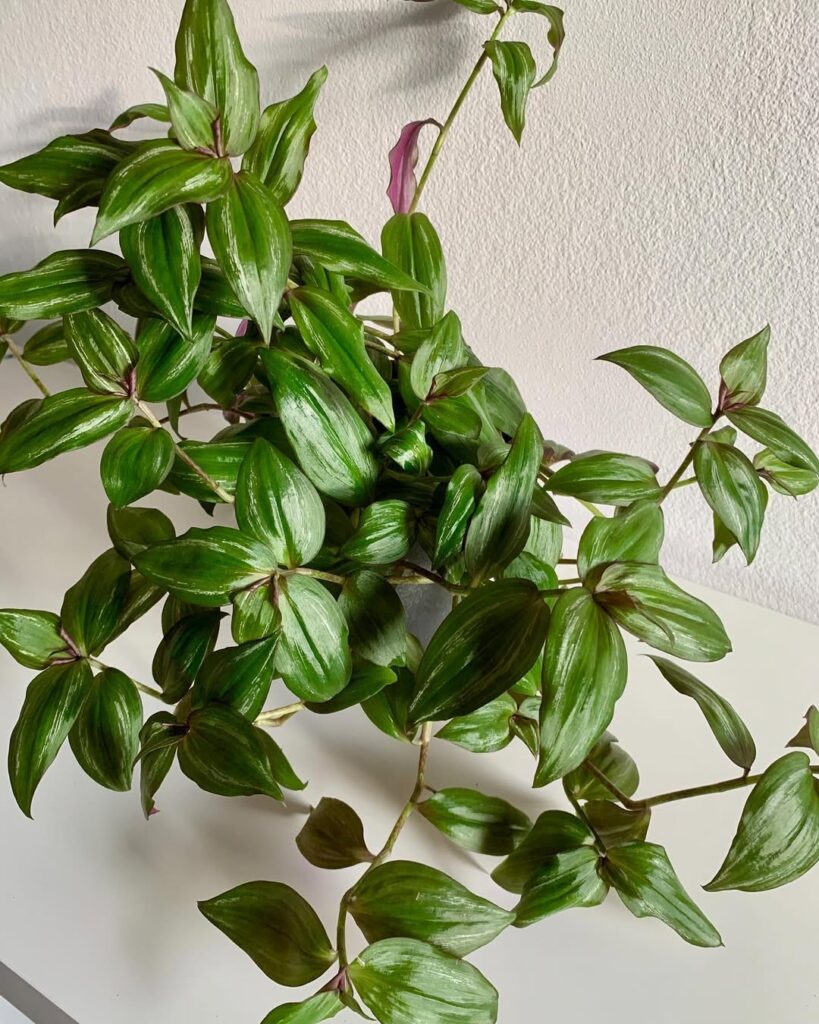
A striking Zebrina variety, Tradescantia Zebrina ‘Flame Dance’ features silvery stripes broken into streaks, distinguishing it from most other Zebrinas. It closely resembles Zebrina Discolor, but while Discolor has solid stripes, Flame Dance’s stripes are more fragmented, creating a unique visual effect.
Tradescantia Cerinthoides
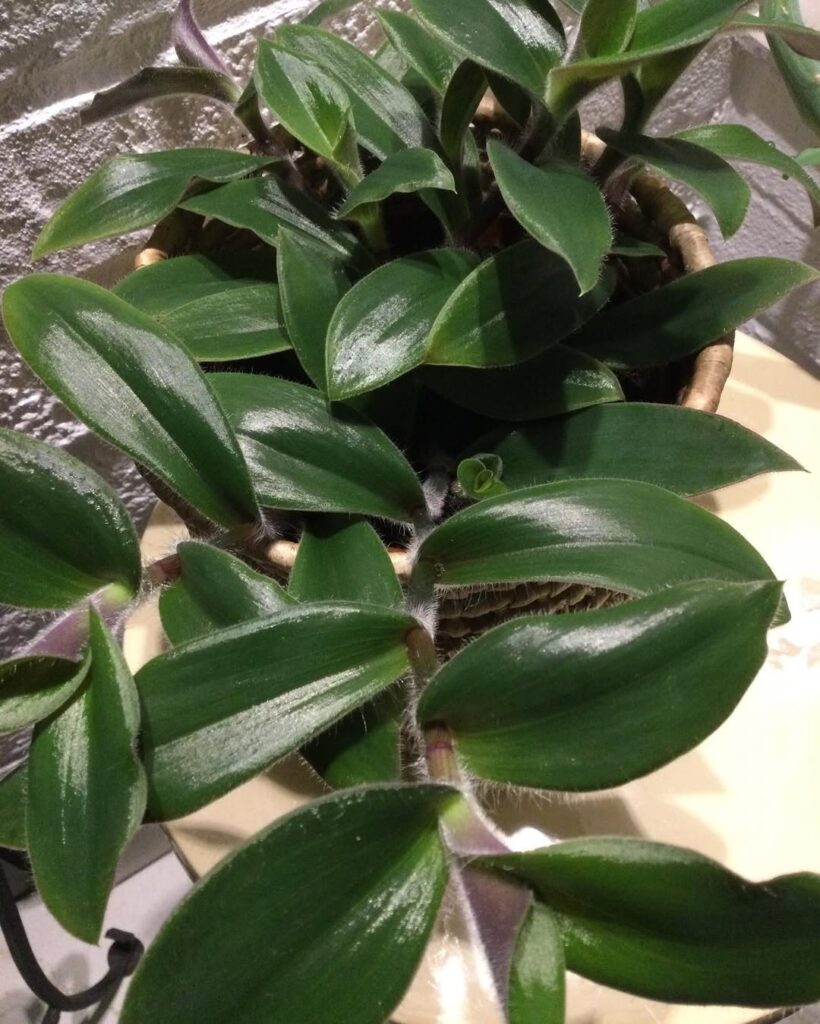
A compact, bushy variety, Tradescantia Cerinthoides (used to be called Tradescantia Blossfeldiana) has deep green leaves with rich purple undersides. It prefers bright, indirect light and occasional watering.
Tradescantia Cerinthoides ‘Red Hill’
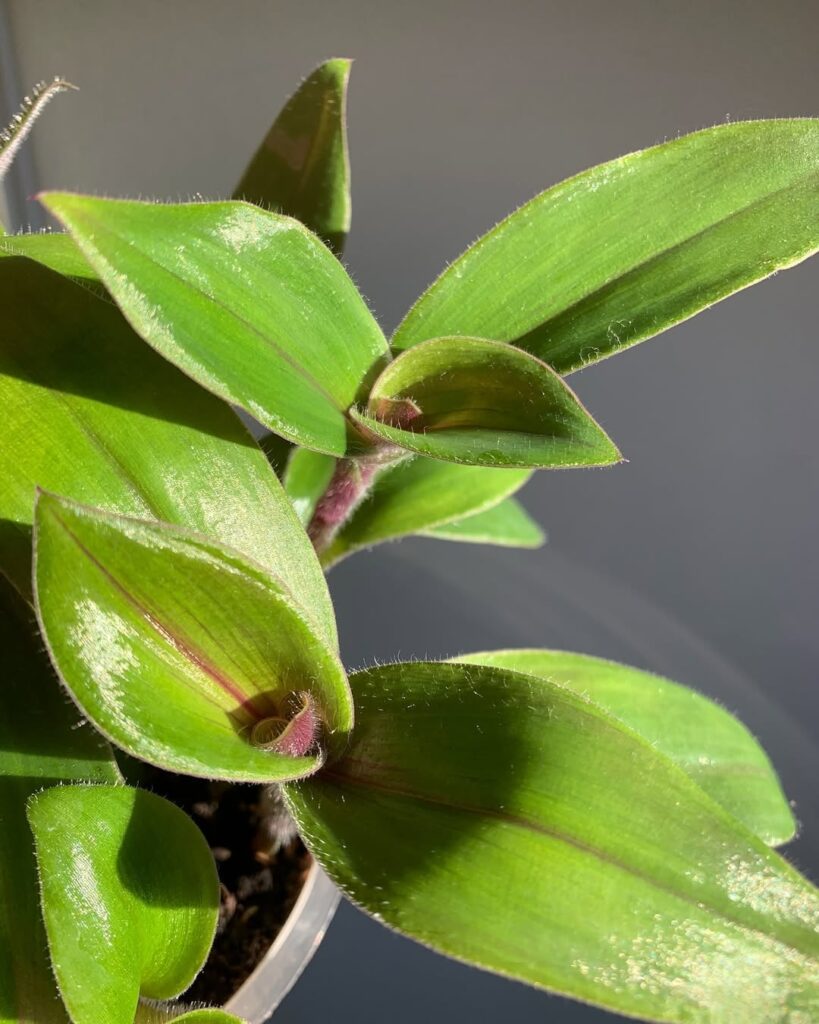
A robust and semi-succulent variety, Tradescantia Cerinthoides ‘Red Hill’ features thicker stems and leaves that store water efficiently, making it highly drought-tolerant. Its hairy leaf undersides add texture, while its growth habit starts upright before trailing as the stems become too heavy to support themselves. This cultivar thrives in bright, indirect light and prefers drier conditions, making it an excellent choice for low-maintenance plant lovers.
Tradescantia Cerinthoides ‘Nanouk’

Known for its pastel tones, Tradescantia Nanouk has thick, pink, purple, and green leaves. Its compact growth and resistance to pests make it a favorite among houseplant lovers.
Tradescantia Cerinthoides ‘White Nanouk’
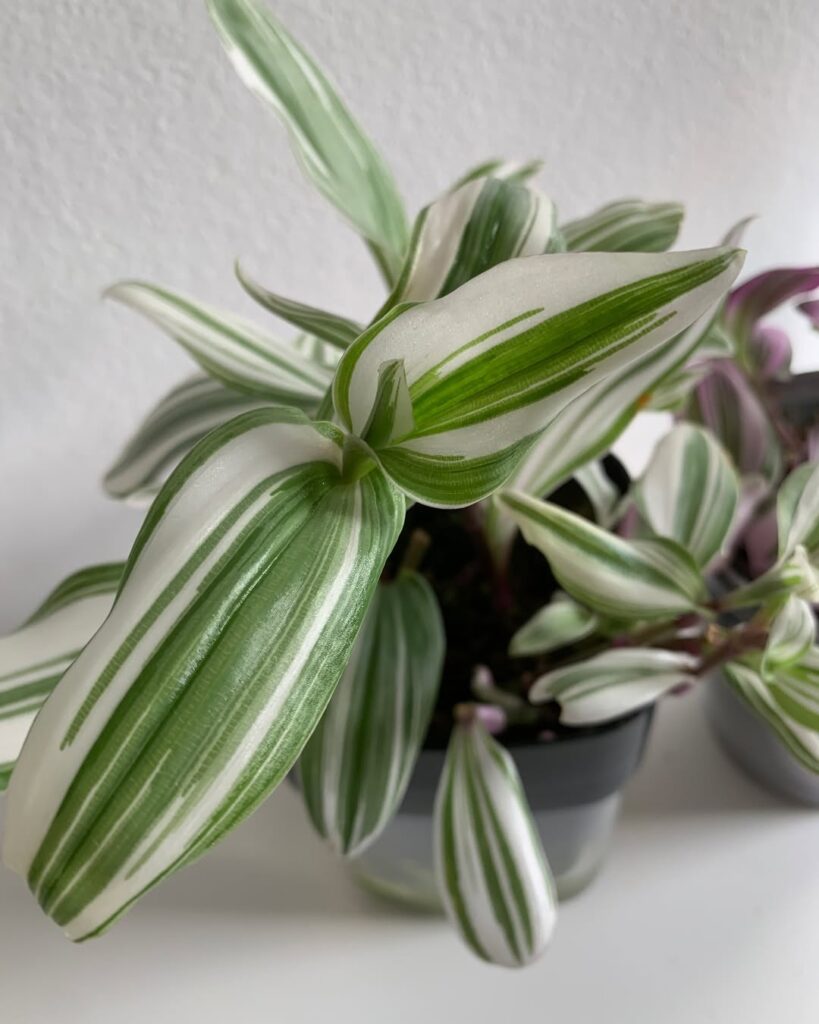
A striking cultivar, Tradescantia Cerinthoides ‘White Nanouk’ features elongated, slightly pointed leaves with green and white variegation, creating a visually appealing striped pattern. Its compact growth habit makes it ideal for trailing displays, and under bright light, its variegation remains crisp and vibrant.
Tradescantia Cerinthoides ‘Green Nanouk’

Tradescantia Cerinthoides ‘Green Nanouk’ likely originated from reverted stems of Tradescantia cerinthoides ‘Nanouk’, a phenomenon observed multiple times, leading to its recognition as a distinct variety. Its vibrant green upper leaves contrast strikingly with deep, dark purple undersides, creating a dramatic visual effect. Like other Cerinthoides varieties, it features thick stems and robust leaves, making it highly drought-resistant, an excellent trait for those who may forget to water regularly.
Tradescantia Cerinthoides ‘Limelight’
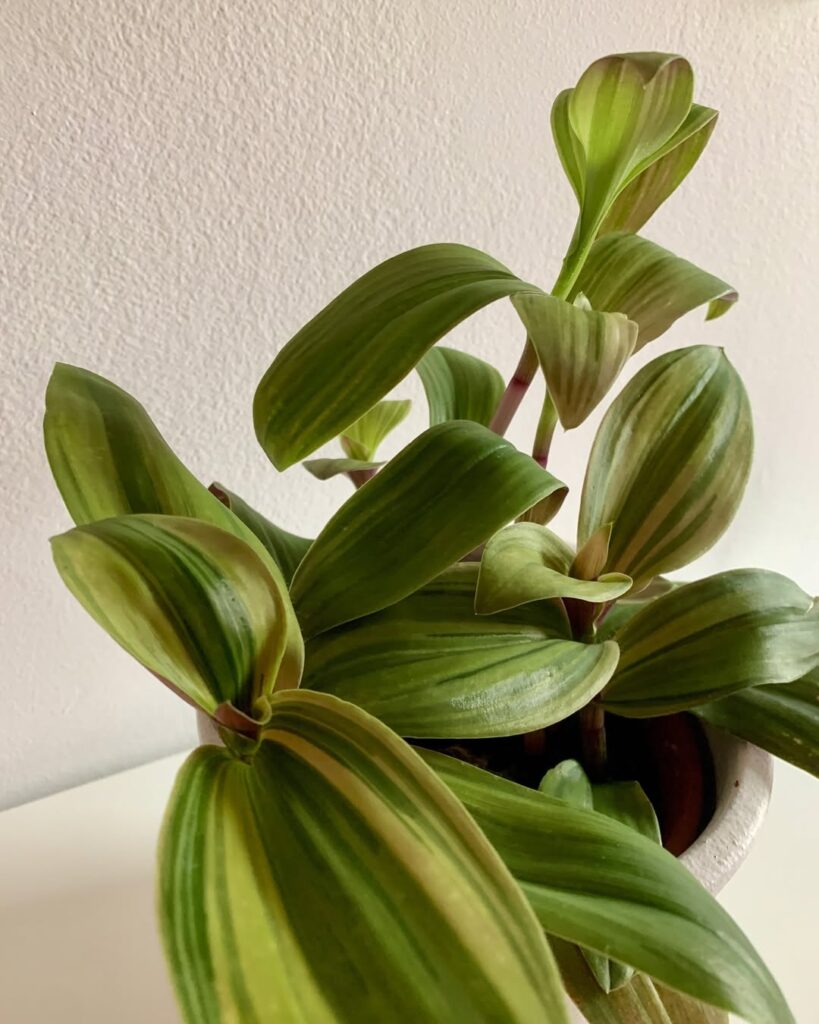
A vibrant cultivar, Tradescantia Cerinthoides ‘Limelight’ resembles Nanouk but features bright green variegation with striking yellow stripes. Like other Cerinthoides varieties, it has thick stems and large leaves, allowing it to tolerate drying out better than many Tradescantias. When it blooms, it produces white flowers with delicate pink tips, adding to its charm.
Tradescantia Cerinthoides ‘Pink Furry’
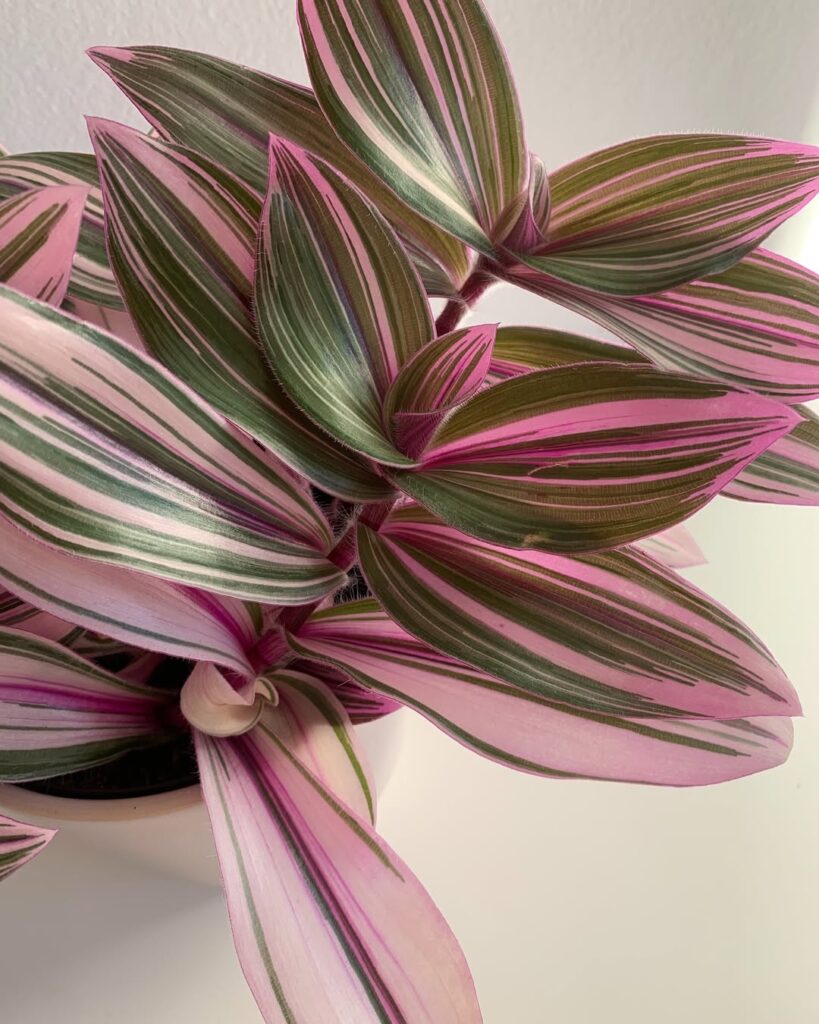
Tradescantia Pink Furry is a unique member of the Cerinthoides species, distinguished by its larger, thicker leaves and stems, which store water well, allowing it to tolerate drying out. Initially growing upright, its stems eventually fall over and start trailing as they lengthen. Resembling Nanouk, its defining trait is the fine hairs covering the undersides of its leaves, often accompanied by a darker pink stripe running down the center. Its color varies with light—lower light creates pale, cream-toned leaves, while brighter light enhances its vibrant pink hues, making it a standout in any collection.
Tradescantia Pallida
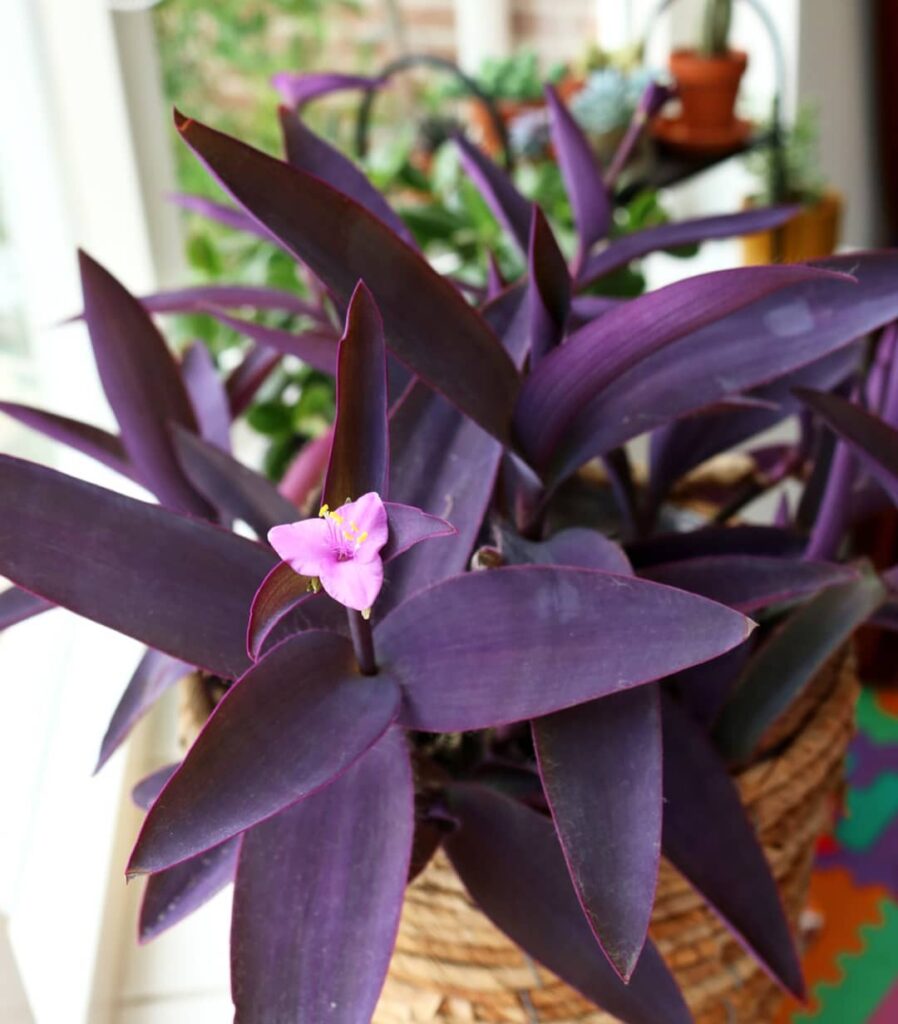
Also called Tradescantia Purple Heart, this variety features deep purple, lance-shaped leaves. It grows quickly and thrives in warm, sunny spots, adding a dramatic pop of color to any collection.
Tradescantia Pallida ‘Pink Stripe‘
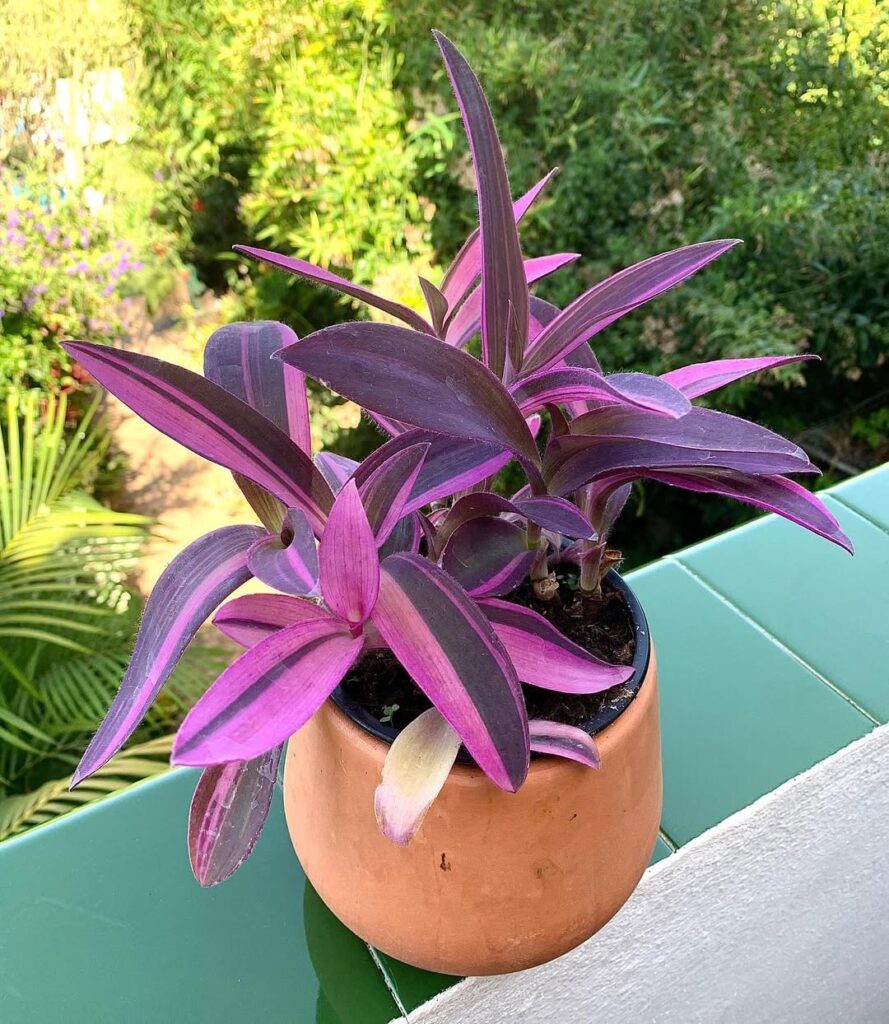
A stunning variation of Tradescantia Pallida, this cultivar features striped pink, green, and purple leaves. It thrives in bright light and develops richer colors with more sun exposure, making it a striking addition to any plant collection.
Tradescantia Pallida ‘Blue Sue‘

A distinctive cultivar, Tradescantia Pallida ‘Blue Sue’ develops a bluish-green hue under optimal lighting conditions, setting it apart from other Pallida varieties. Its elongated, lance-shaped leaves may also display a slight purple tint along the edges, adding to its visual appeal. Like most Pallida species, it produces small purple flowers, though blooming can be sporadic.
Tradescantia Pallida ‘Shadow Hill‘
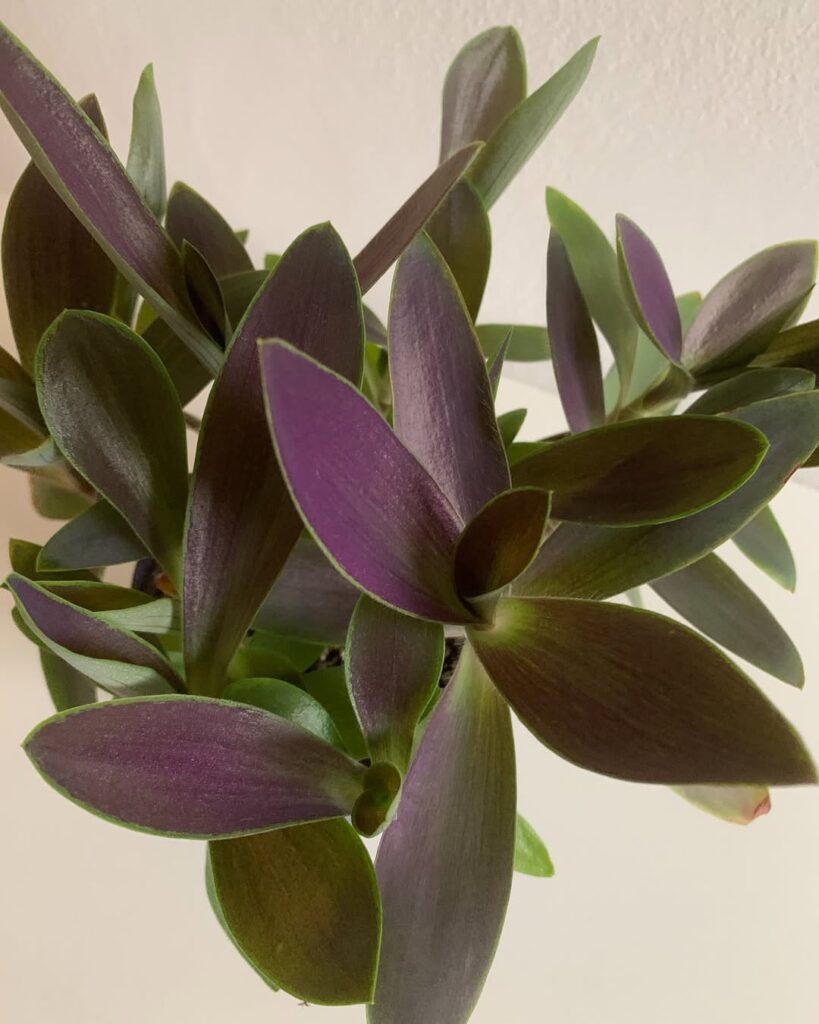
A fascinating mutation of Tradescantia Pallida ‘Purpurea’, ‘Shadow Hill’ stands out due to its unusual leaf coloration. Unlike most Tradescantia varieties, which have darker undersides and lighter upper surfaces, Shadow Hill reverses this pattern—its upper leaves are dark greyish-purple, while the undersides are a lighter green. When it blooms, it produces delicate light purple flowers, adding to its unique charm.
Tradescantia Pallida ‘Purple Pixie‘
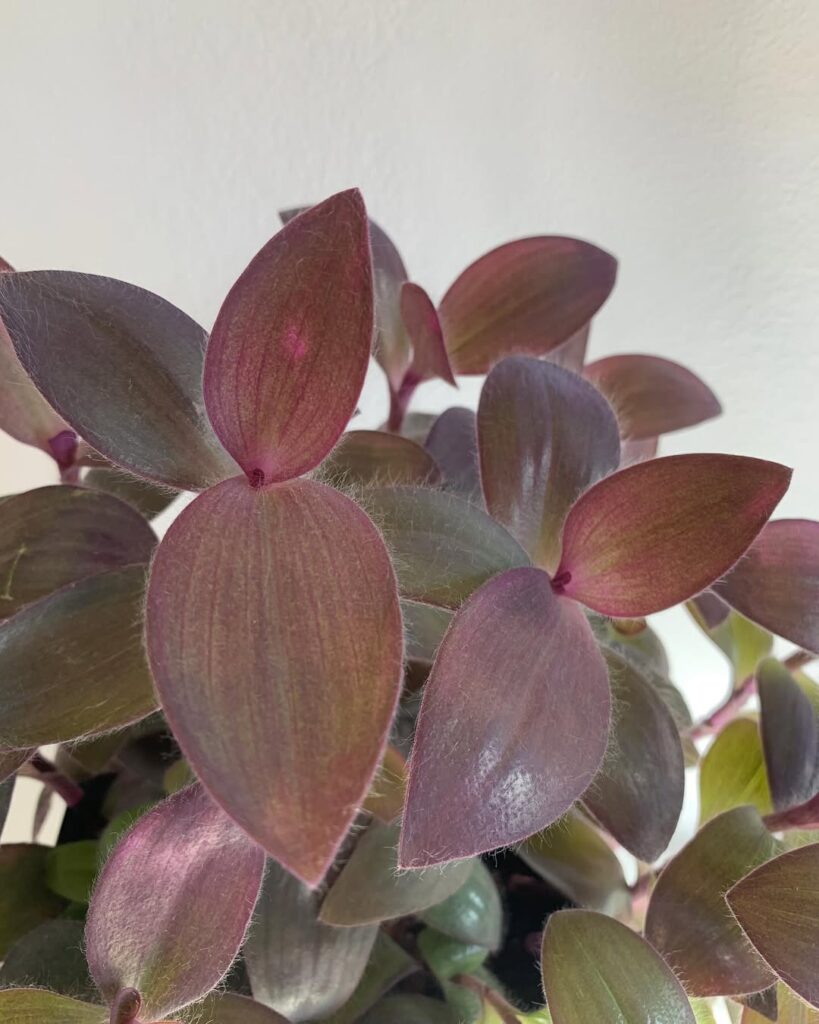
A newer cultivar, Tradescantia Pallida ‘Purple Pixie’ is often confused with the older Purpurea variety, as both are sometimes incorrectly labeled Purple Heart, Purple Queen, or Purple Passion. However, Purple Pixie has a more vivid purple color, with shorter, wider leaves, while Purpurea has longer, narrower leaves with a gray-purple tone. Purple Pixie is a fast-growing variety with thick, dark purple foliage, though its color can shift depending on light exposure.
Tradescantia Pallida ‘Kartuz Giant‘
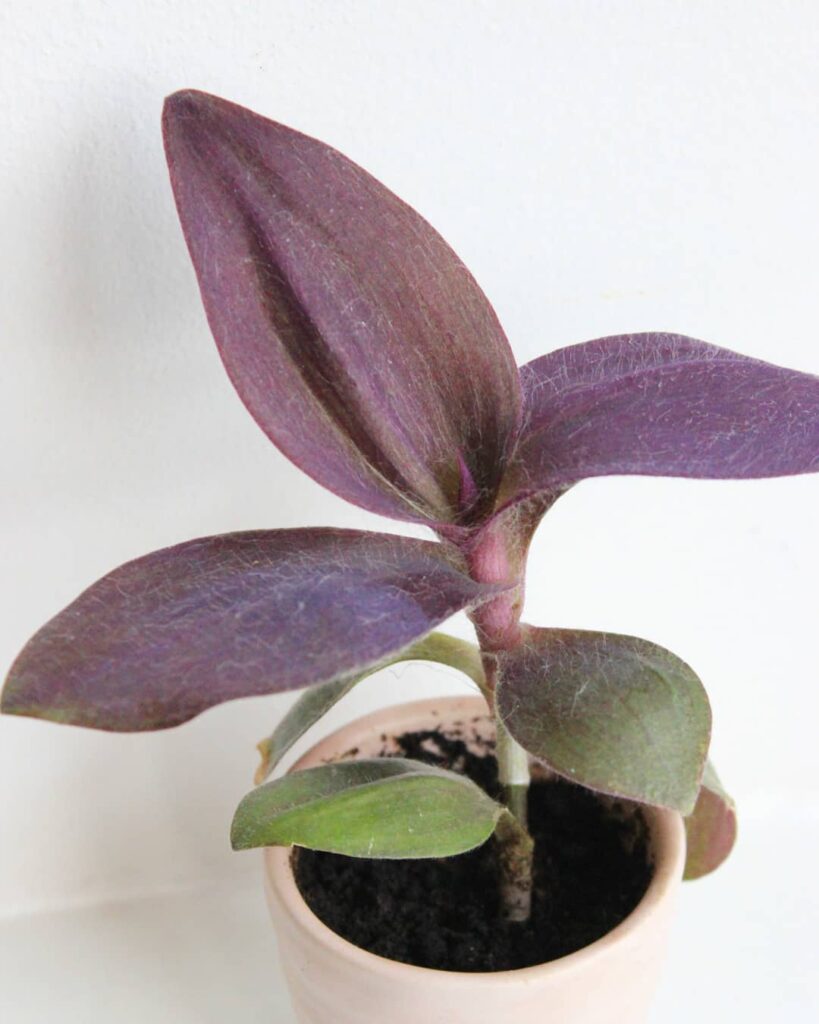
Also known as Biltmore Bimbo or Big Bertha, Tradescantia Pallida ‘Kartuz Giant’ stands out with its large, broad leaves, which often fold due to their width. Tiny hairs are scattered across the leaf surface, adding texture, and under bright light, the foliage develops a rich purple hue. This variety is a slow grower.
Tradescantia Sillamontana
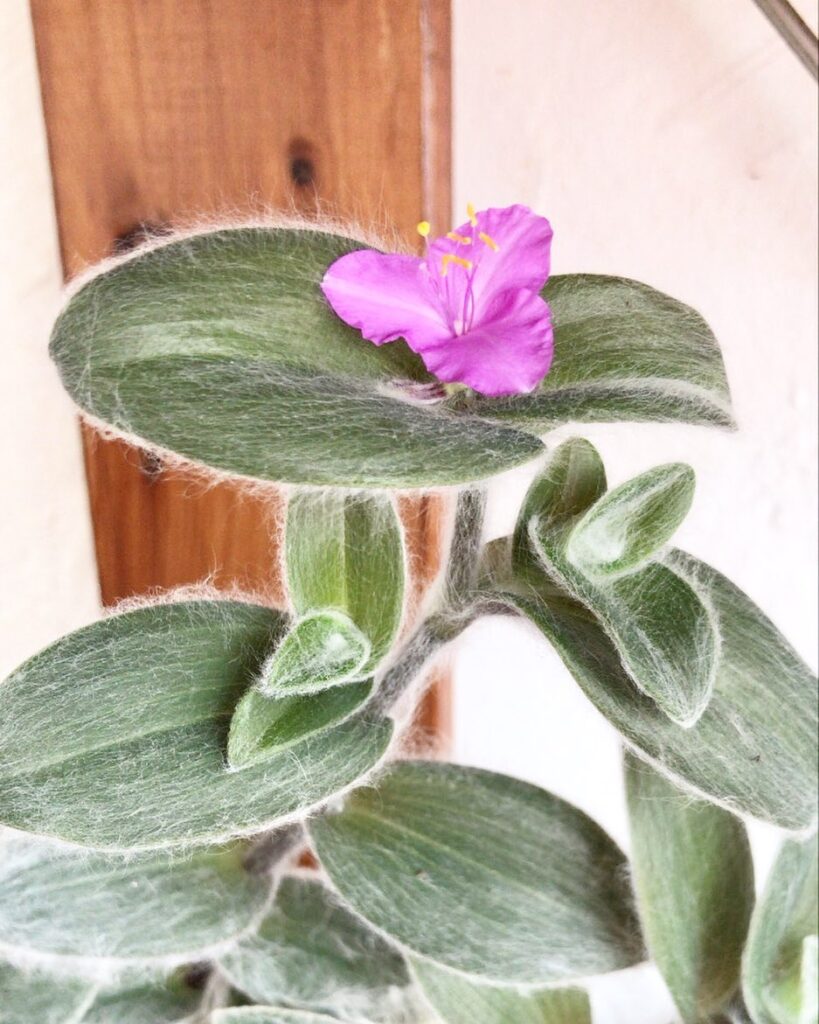
This unique plant is often called White Velvet because of its fuzzy, silver-green leaves. It prefers dry conditions and requires minimal watering, making it ideal for forgetful plant owners.
Tradescantia Sillamontana Variegata
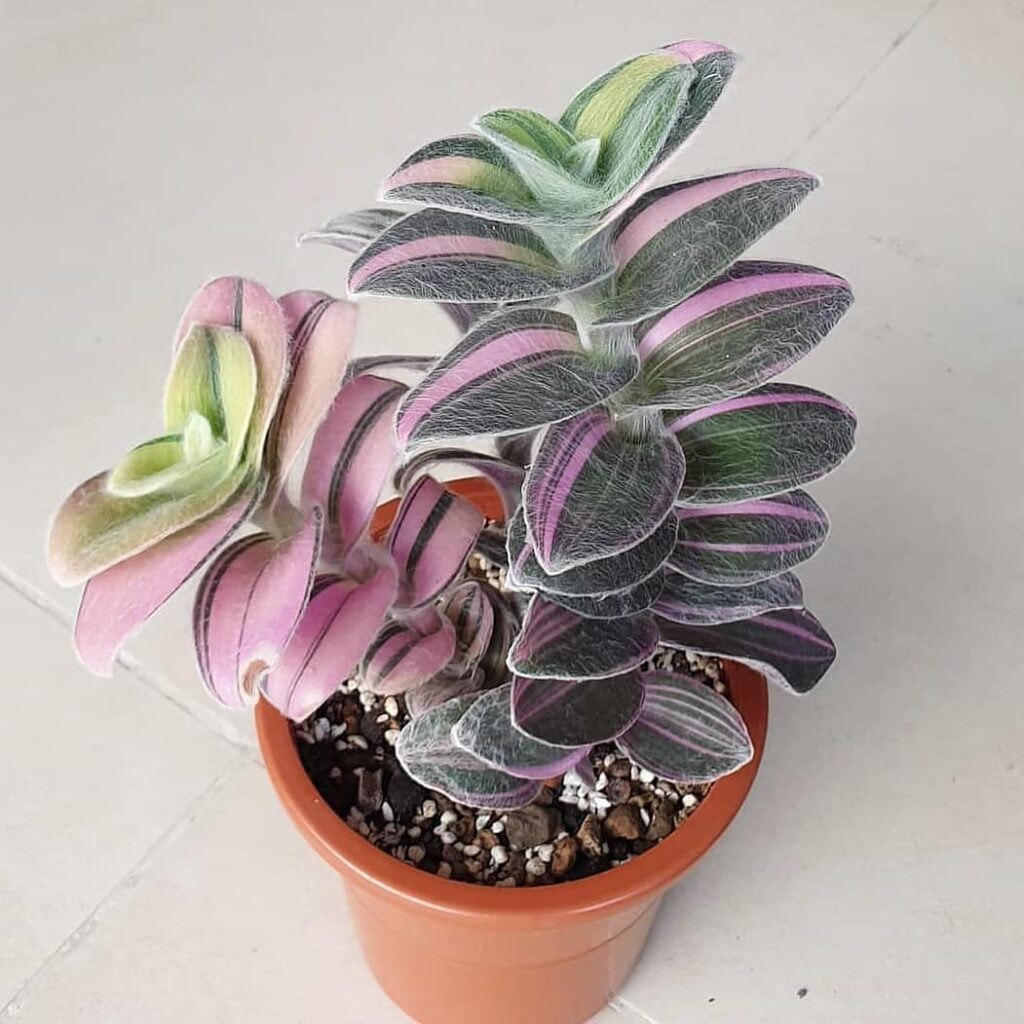
A rare and visually striking variation of Tradescantia Sillamontana, this cultivar features green, pink, and purple variegated leaves with a fuzzy texture. It thrives in bright, indirect light and requires minimal watering, making it ideal for low-maintenance plant collections.
Tradescantia Sillamontana ’Gold Stripes’
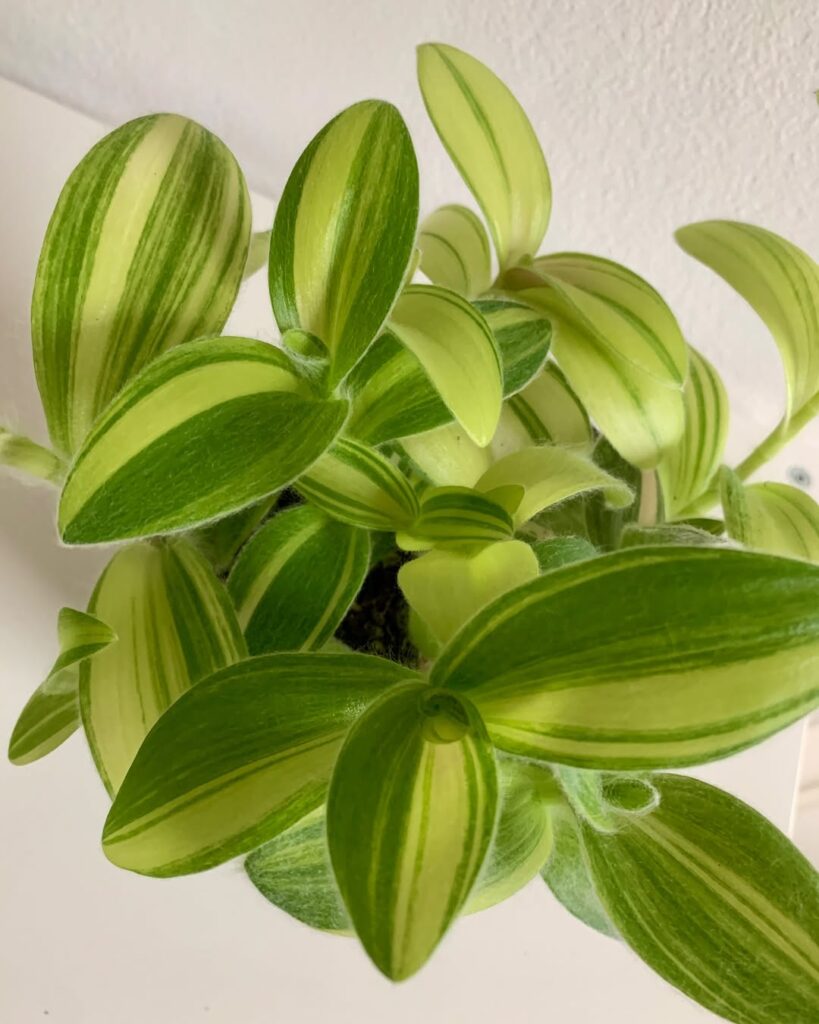
A rare and visually striking cultivar, Tradescantia Sillamontana ‘Gold Stripes’ features green leaves with bold yellow variegation. The foliage is covered in fine white hairs, giving it a velvety texture. It thrives in bright, indirect light and prefers dry conditions, making it an excellent low-maintenance plant.
Tradescantia Fluminensis
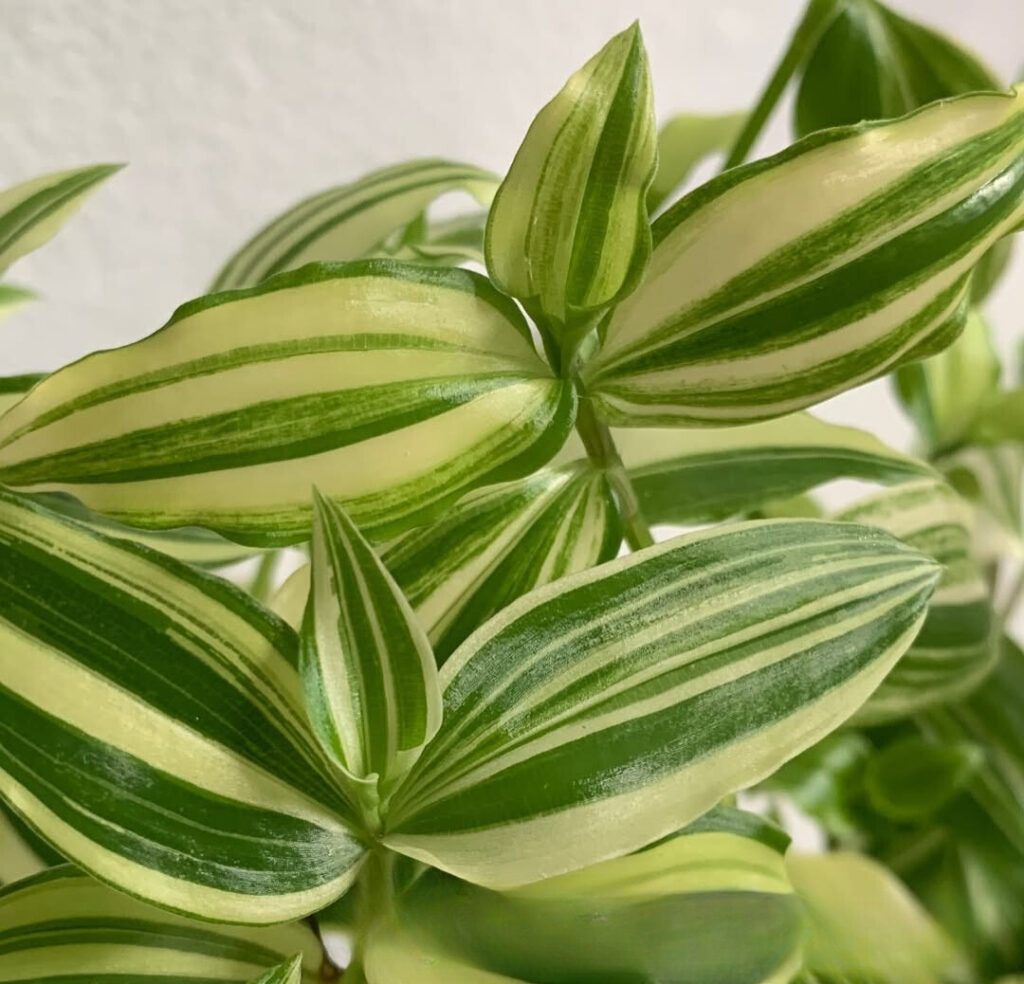
Tradescantia Fluminensis, also known as small-leaf spiderwort or wandering Jew, is a trailing perennial native to South America. It features elongated, glossy green leaves with white variegation, creating a striking contrast. This variety thrives in moist, well-drained soil and prefers semi-shade, though it can tolerate bright, indirect light.
Tradescantia Fluminensis Variegata
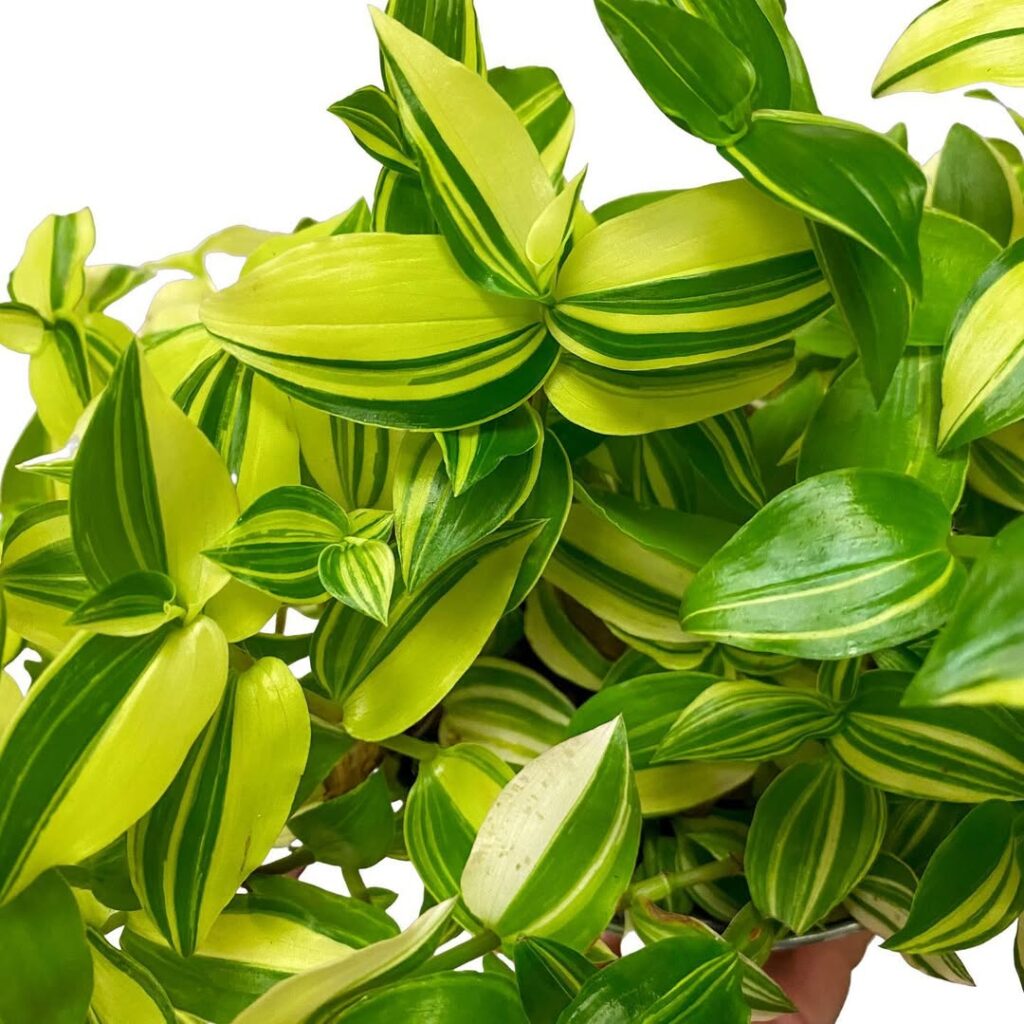
A striking variegated form of Tradescantia Fluminensis, this cultivar features elongated green leaves with bold yellow streaks. Its trailing habit makes it perfect for hanging baskets, and it thrives in bright, indirect light with moderate watering. The contrast between its vibrant foliage and delicate growth pattern adds a unique touch to any indoor plant collection.
Tradescantia Fluminensis ‘Yellow Hill’
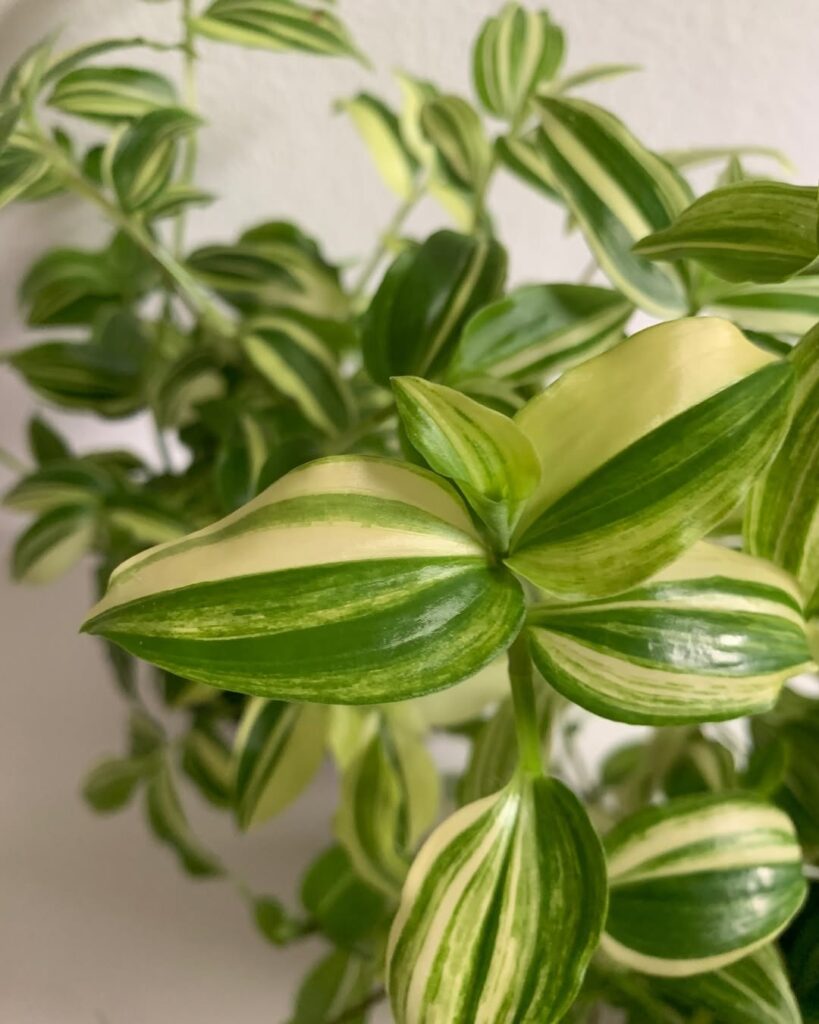
A vibrant yellow-green cultivar, Tradescantia Fluminensis ‘Yellow Hill’ is often mistaken for ‘Variegata’, but they are distinct. Both feature yellow variegation that ranges from subtle streaks to full-leaf coverage and share a similar growth habit with comparable leaf sizes. The key difference lies in the stripe pattern—‘Variegata’ has sharper-edged stripes, while ‘Yellow Hill’ displays softer, more blurred markings. Some describe ‘Yellow Hill’ as having a brighter yellow hue, while ‘Variegata’ leans toward a creamier tone, though this can shift based on environmental conditions.
Tradescantia Fluminensis ‘Aurea’
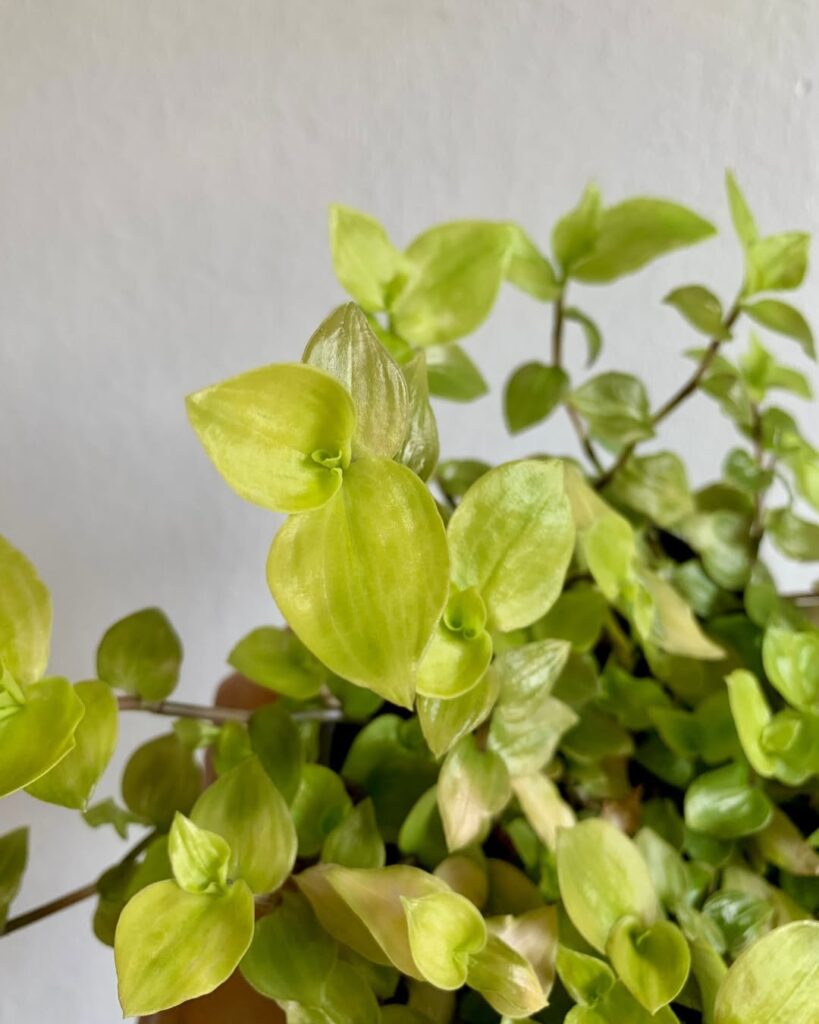
Often mistakenly labeled as Gold Wing or Trailing Gold, Tradescantia Fluminensis ‘Aurea’ is known for its yellow-green foliage, which becomes even more vibrant in bright light. Like other Fluminensis varieties, it has small leaves, thin stems, and produces delicate white flowers. Its trailing habit makes it a charming addition to any collection.
Tradescantia Fluminensis ‘Albovittata’
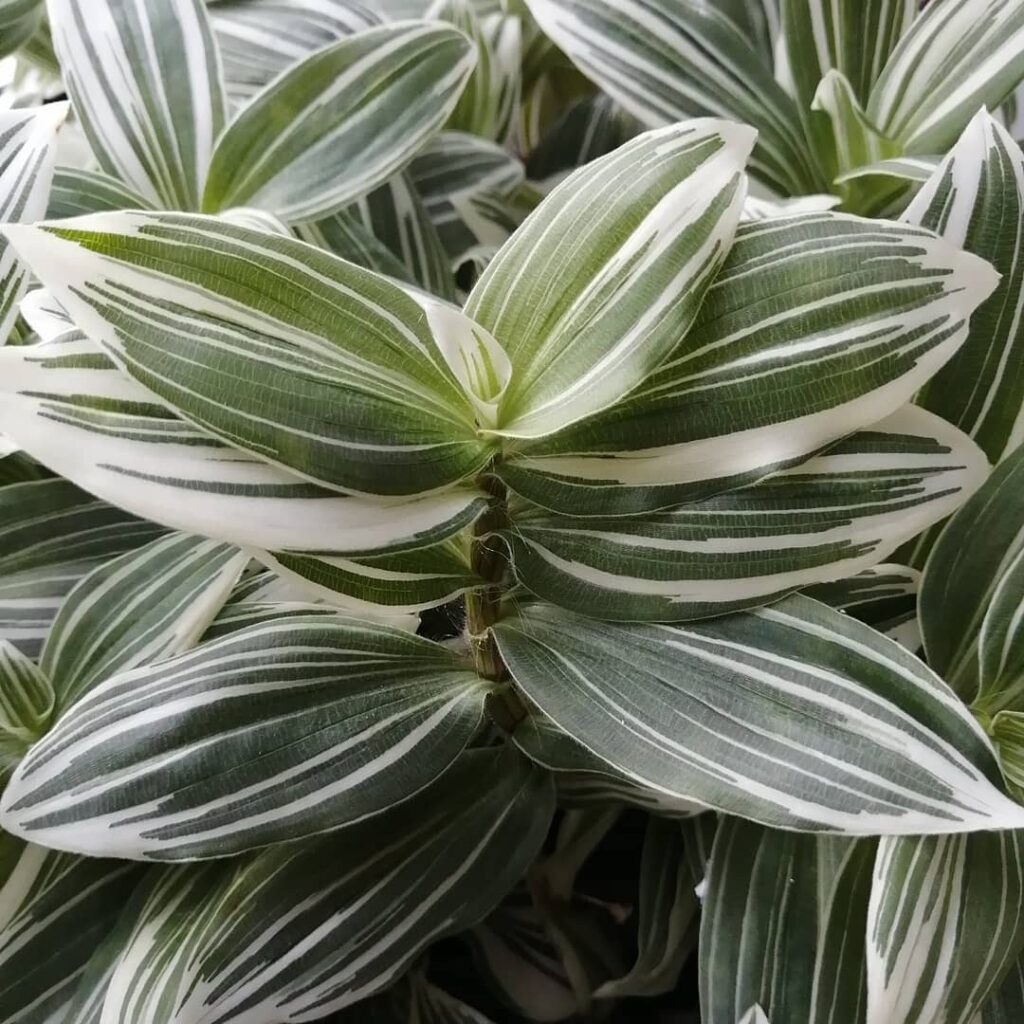
A stunning variegated cultivar, Tradescantia Fluminensis ‘Albovittata’ features elongated green leaves with striking white stripes running parallel to the veins. The foliage is dense and lush, making it a perfect trailing plant for hanging baskets or decorative pots. It thrives in semi-shade with moderate watering, ensuring its vibrant variegation remains prominent.
Tradescantia Fluminensis ‘Tricolor’
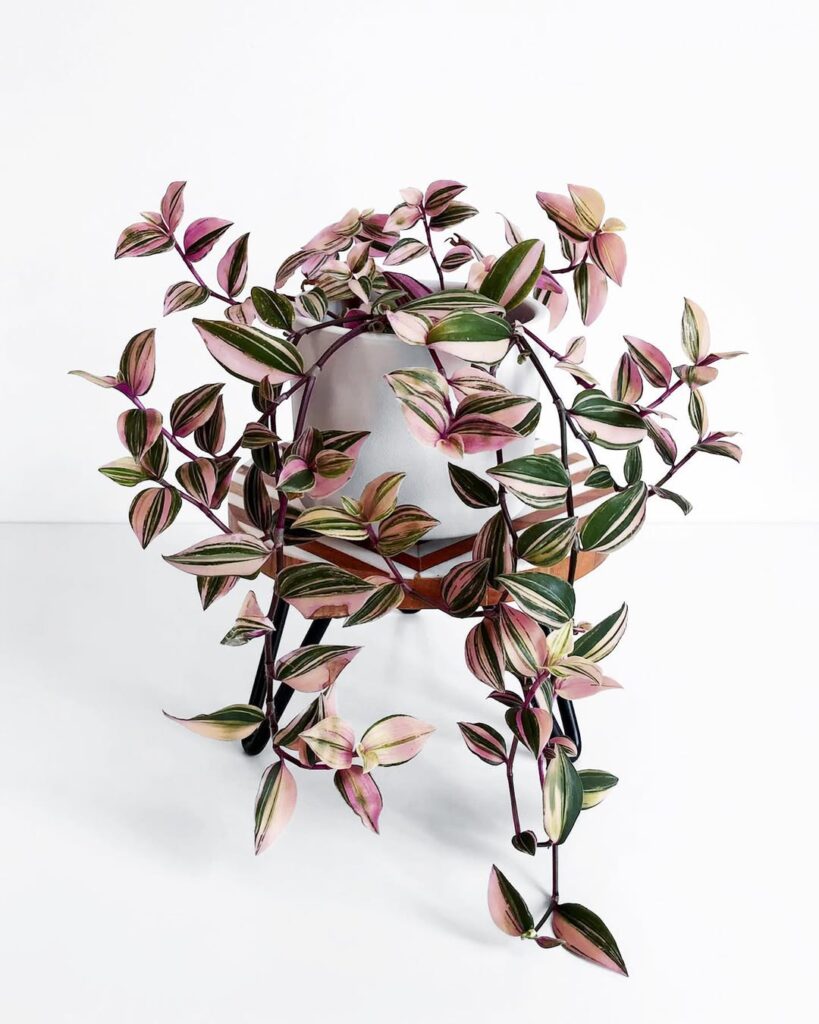
A vibrant and eye-catching variety, Tradescantia Fluminensis ‘Tricolor’ features green, pink, and white variegated leaves that create a stunning contrast. This trailing plant thrives in bright, indirect light and enjoys moderate watering, making it a perfect choice for hanging baskets or decorative pots. Its fast-growing nature allows it to quickly fill spaces with lush foliage.
Tradescantia Fluminensis ‘Lilac’
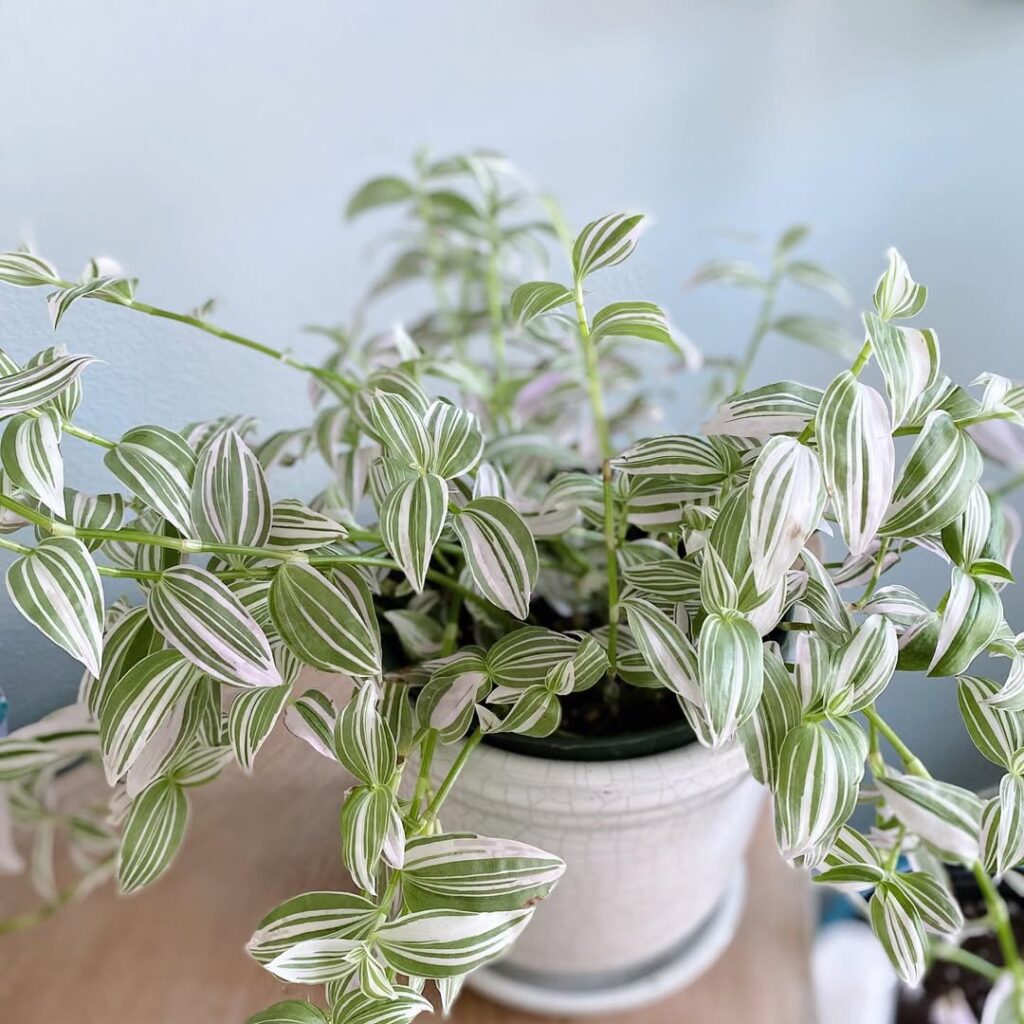
A mesmerizing cultivar, Tradescantia Fluminensis ‘Lilac’ features green and white striped leaves with a delicate lilac or pinkish hue. Its cascading growth makes it perfect for hanging baskets, and it thrives in bright, indirect light with moderate watering. This variety adds a soft, pastel charm to any indoor plant collection.
Tradescantia Spathacea
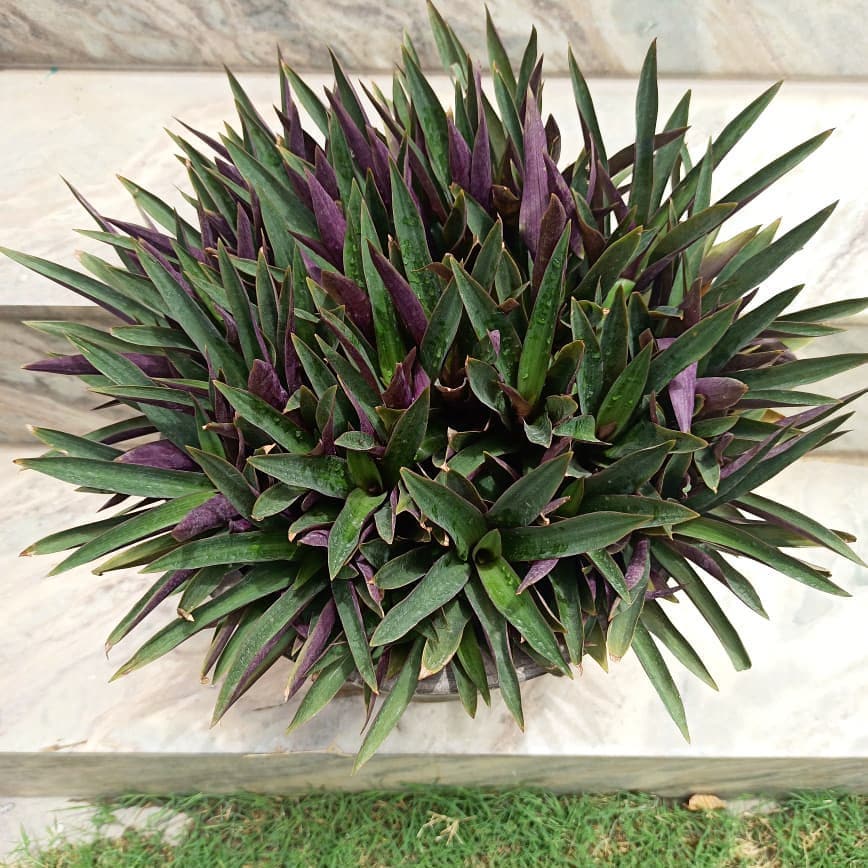
Commonly known as Moses-in-the-Cradle, this variety features sword-like leaves with deep green tops and rich purple undersides. It adds a tropical touch to any indoor space.
Tradescantia Spathacea ‘Tricolor’
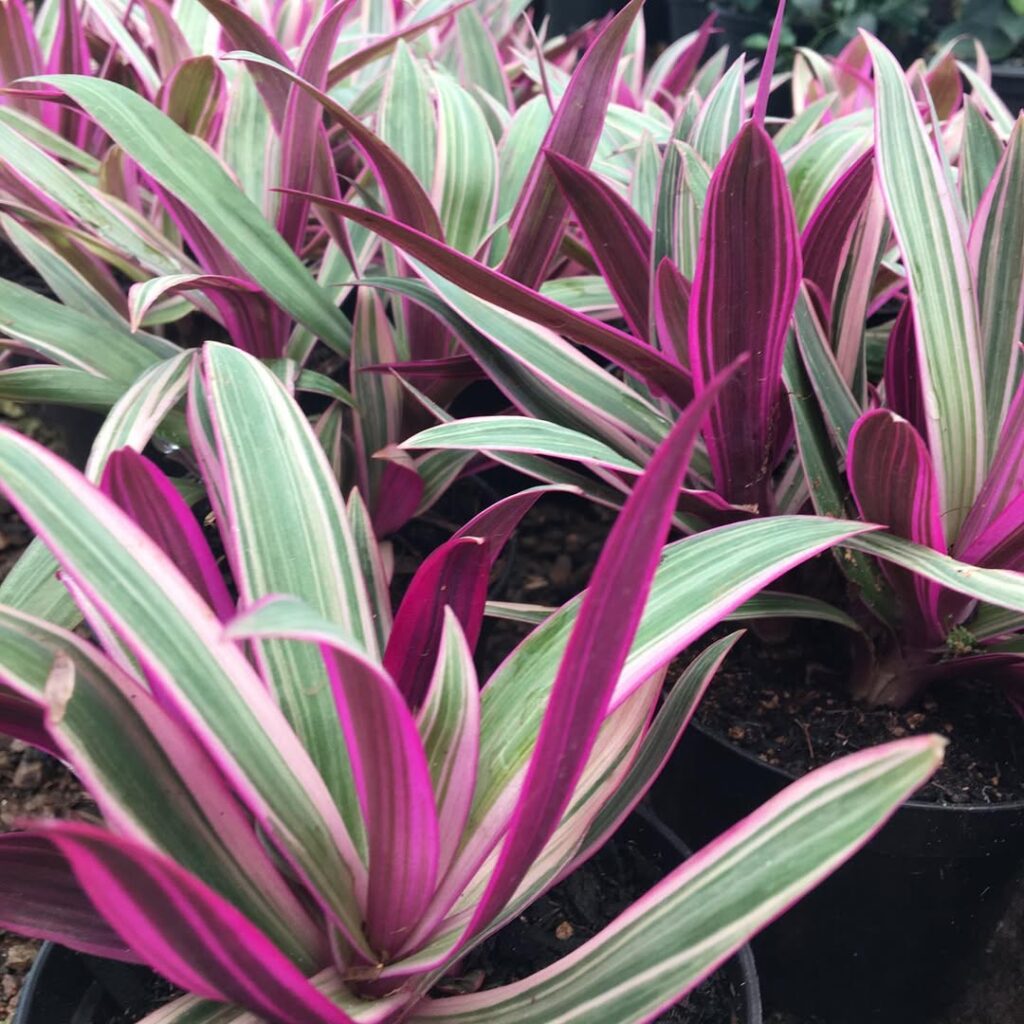
A vibrant and ornamental variety, Tradescantia Spathacea ‘Tricolor’ features elongated, pointed leaves with striking green, white, and pink stripes. The underside of the leaves is a rich purple, adding depth to its visual appeal. This hardy plant thrives in bright, indirect light and prefers moderate watering, making it an excellent choice for indoor gardens or decorative pots. Its bold coloration and structured growth pattern make it a standout addition to any collection.
Tradescantia Spathacea ‘Sitara’
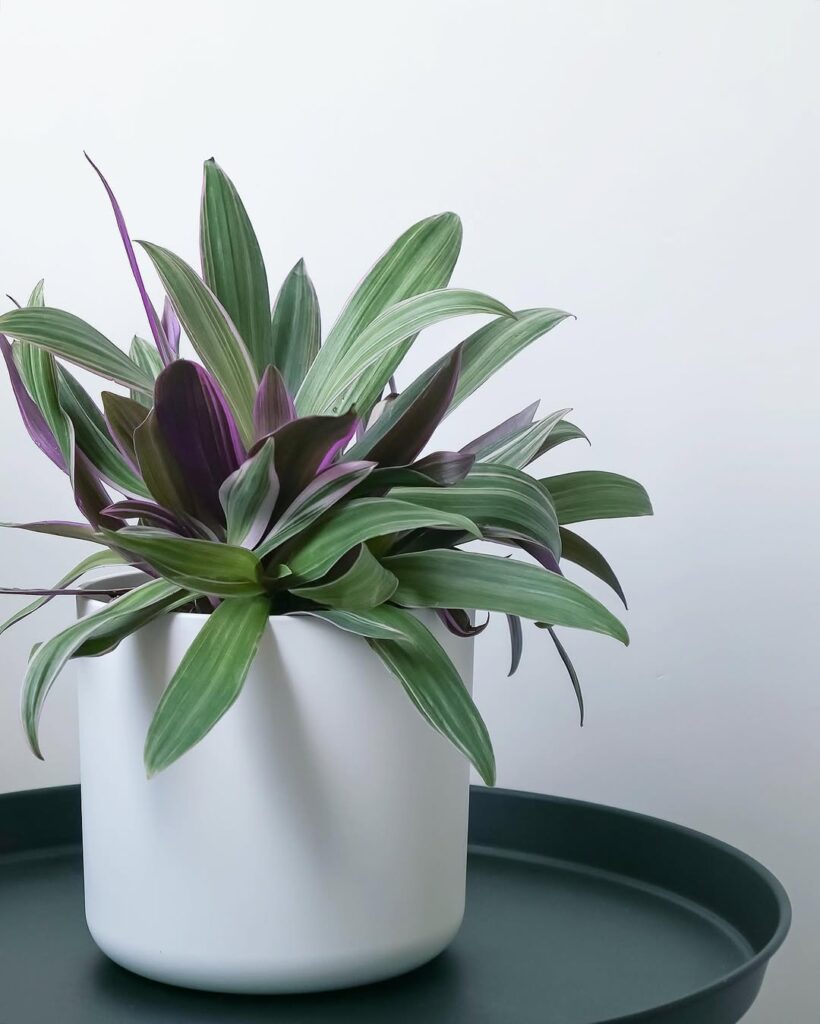
A striking cultivar of Tradescantia Spathacea, ‘Sitara’ features long, pointed leaves with a mix of green and purple hues. The striped pattern on its foliage adds to its visual appeal, making it a standout in any collection. It thrives in bright, indirect light and prefers moderate watering, ensuring its colors remain vibrant. This variety is perfect for decorative pots or as a bold accent in indoor gardens.
Tradescantia Spathacea ‘Sitara Gold’
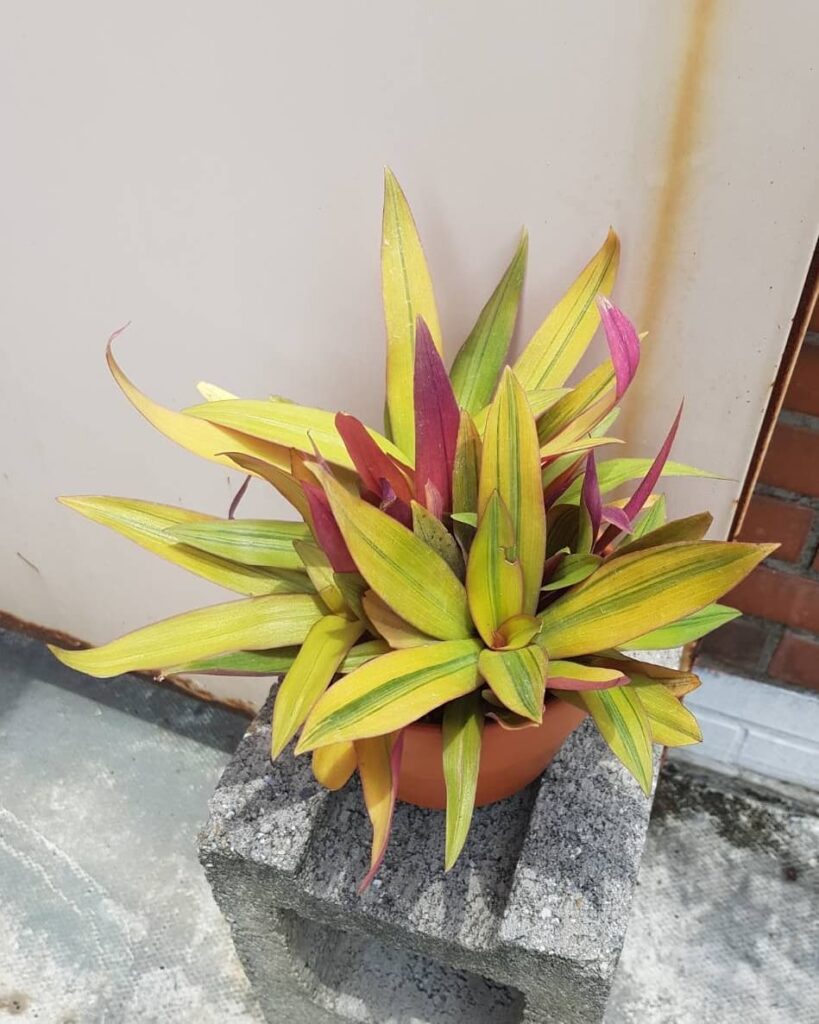
A dazzling cultivar, Tradescantia Spathacea ‘Sitara Gold’ features sword-shaped leaves with a striking blend of gold, green, and subtle pink hues. The underside of the foliage is a rich purple, adding depth to its visual appeal. This variety thrives in bright, indirect light and prefers moderate watering, making it an excellent choice for indoor gardens or decorative pots. Its bold coloration and structured growth pattern make it a standout addition to any collection.
Tradescantia Spathacea ‘Concolor’
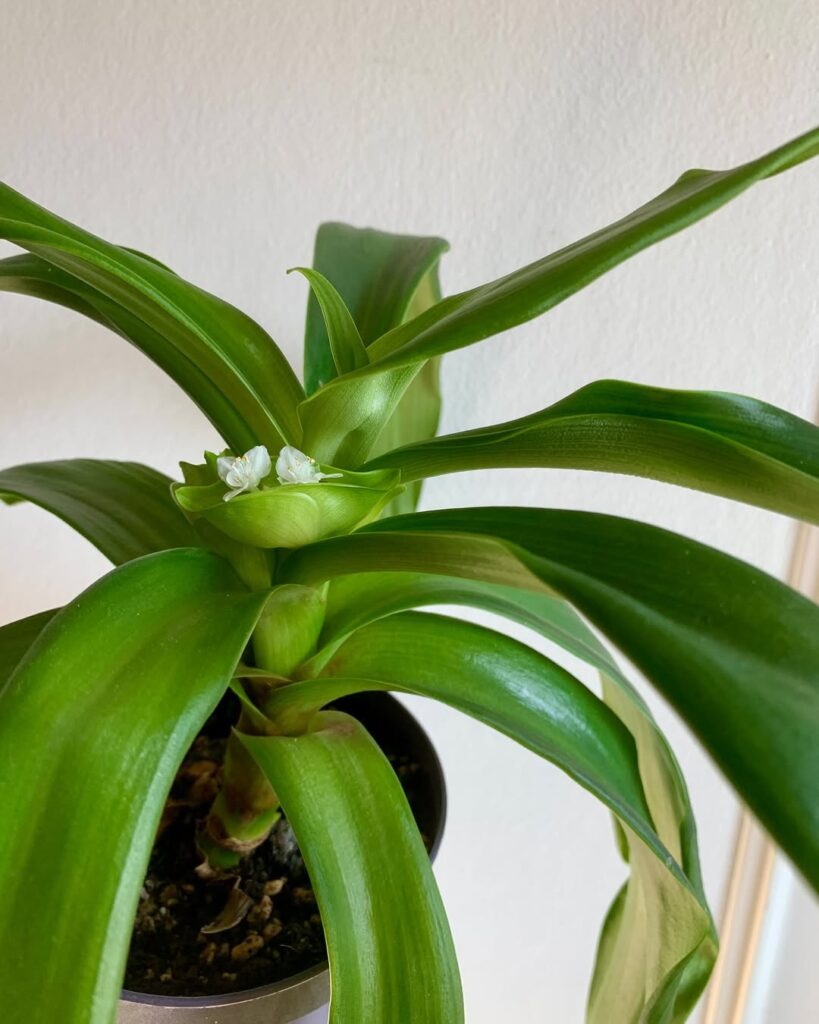
A robust cultivar, Tradescantia Spathacea ‘Concolor’ is larger than most other Spathacea varieties, with only ‘Vittata’ reaching a similar size. Like its relatives, it forms compact rosettes of long, pointed leaves, creating a structured and elegant appearance. One of its most fascinating traits is that its flowers develop tucked into small pockets along the stem, adding a unique touch to its growth habit.
Tradescantia Spathacea ‘Vittata’
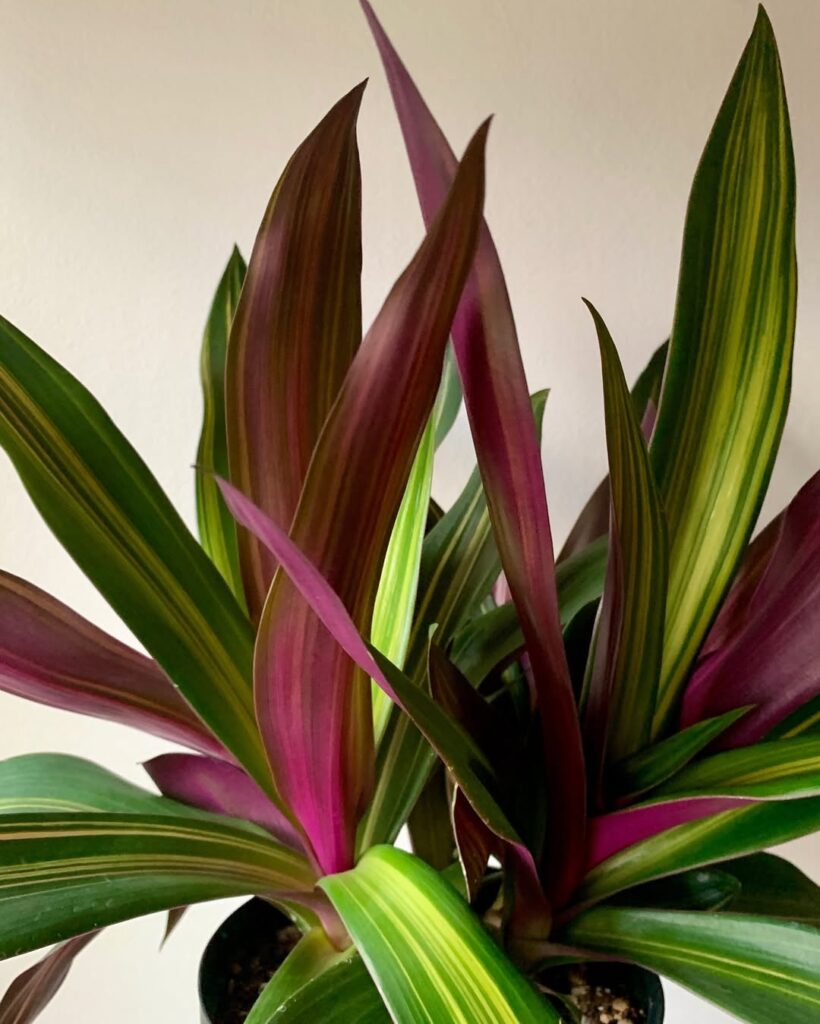
A striking cultivar within the Spathacea species, Tradescantia Spathacea ‘Vittata’ has a distinct upright growth habit, forming large, compact rosettes. Its dark green leaves feature fine yellow stripes running down the center, while the undersides are deep purple, creating a bold contrast. Unlike most Tradescantias, Vittata’s flowers emerge from small pockets nestled between the leaves, adding to its unique charm.
Tradescantia Chrysophylla
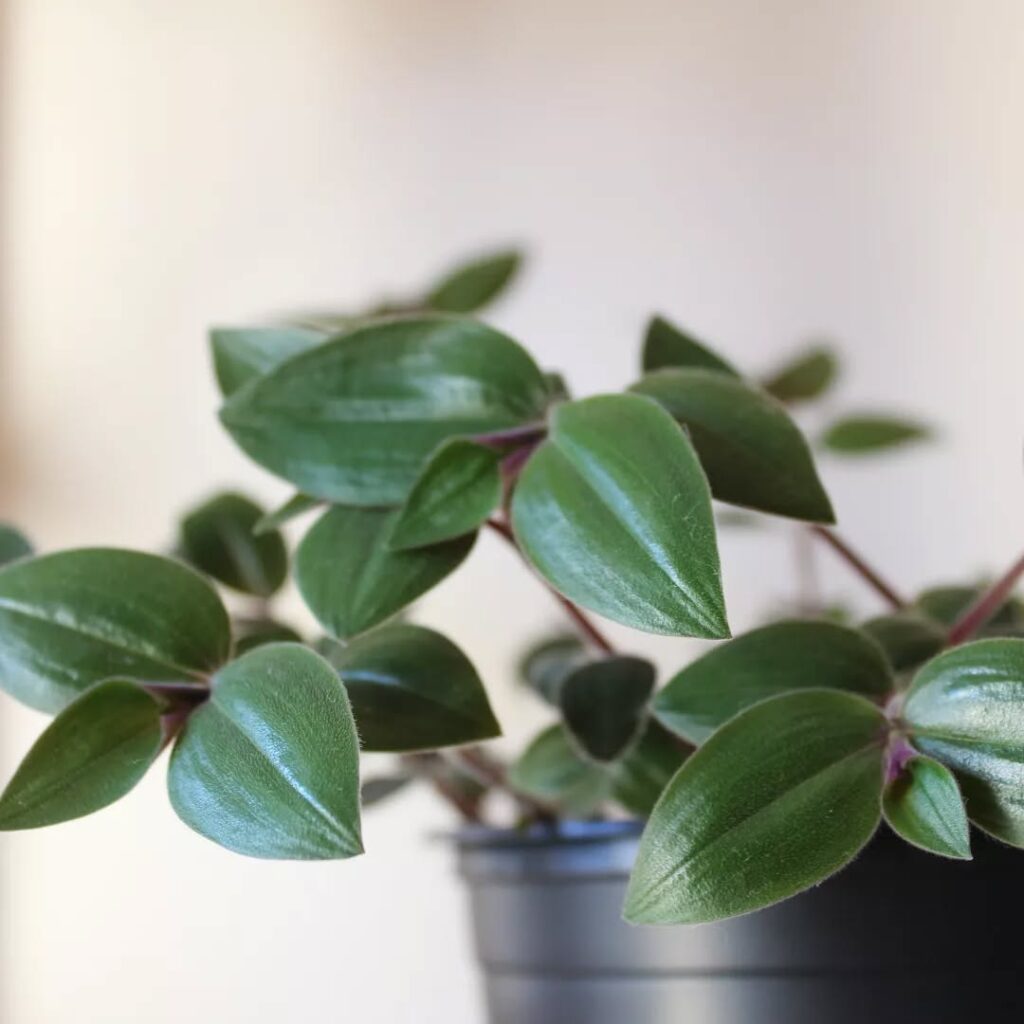
A rare find, Tradescantia Chrysophylla showcases deep green leaves with a delicate trailing habit. It prefers moderate sunlight and moist soil.
Tradescantia Chrysophylla Variegata
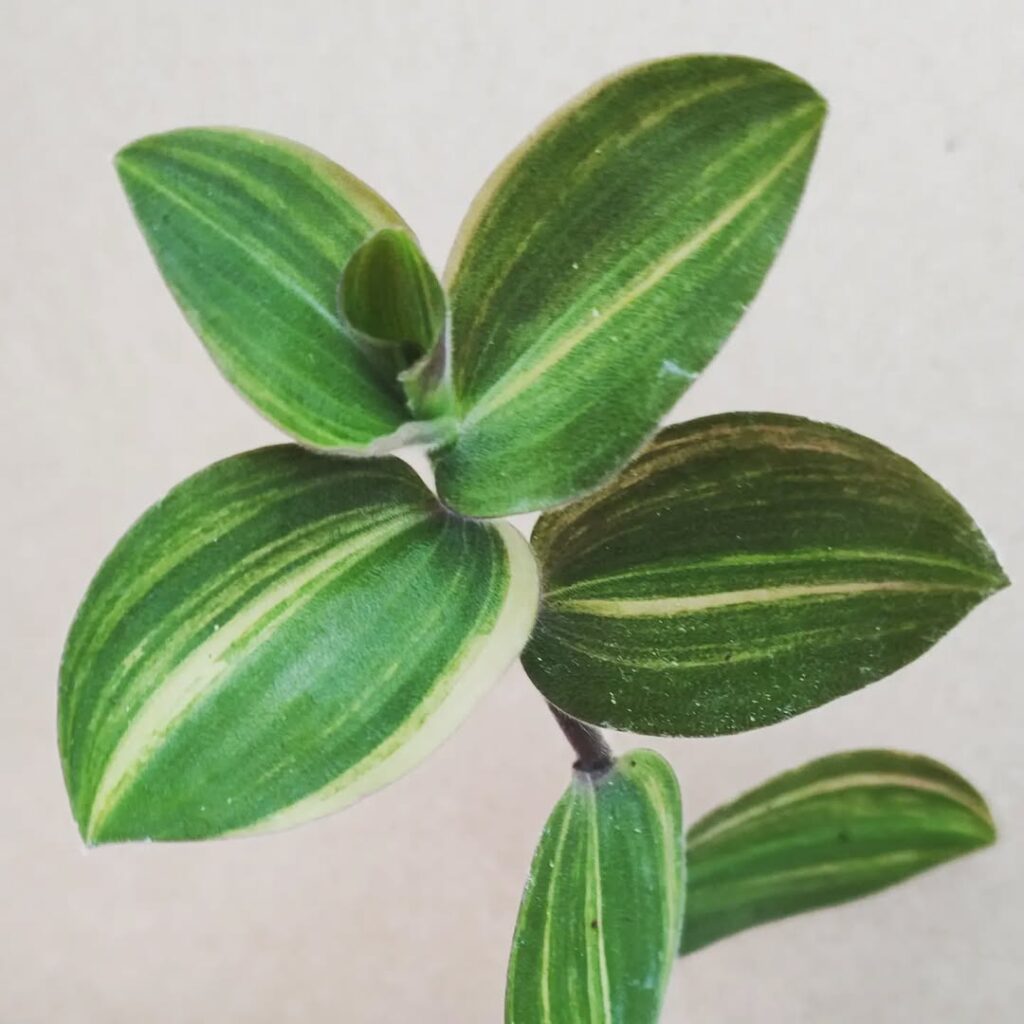
A stunning variegated cultivar, Tradescantia Chrysophylla Variegata features broad, oval-shaped green leaves with distinct cream and lighter green stripes. The foliage has a smooth texture and a trailing habit, making it perfect for hanging baskets or decorative pots. It thrives in bright, indirect light and prefers moderate watering, ensuring its vibrant variegation remains prominent.
Tradescantia Blushing Bride
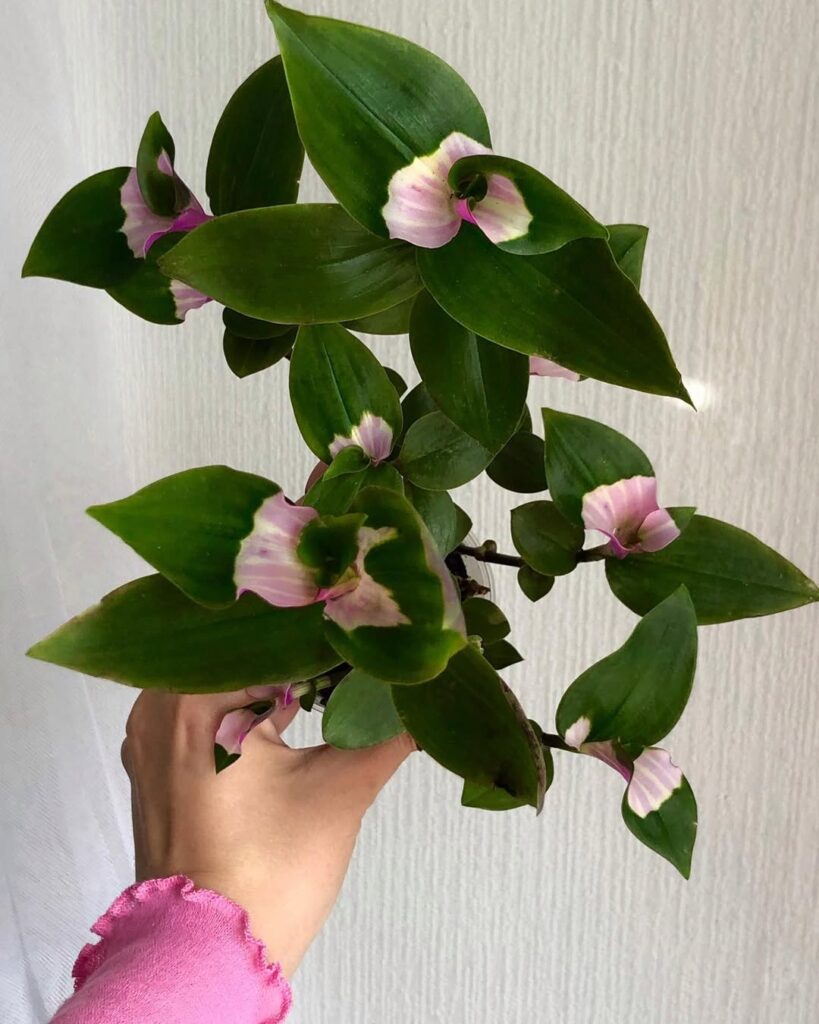
This variety stands out with light pink hues blending into its green leaves. It thrives in indirect light and loves occasional pruning to encourage bushier growth.
Tradescantia Mundula
A robust and adaptable type, Tradescantia Mundula boasts variegated green and white leaves. It’s an easy-care plant perfect for beginners.
Tradescantia Mundula ‘Variegata’
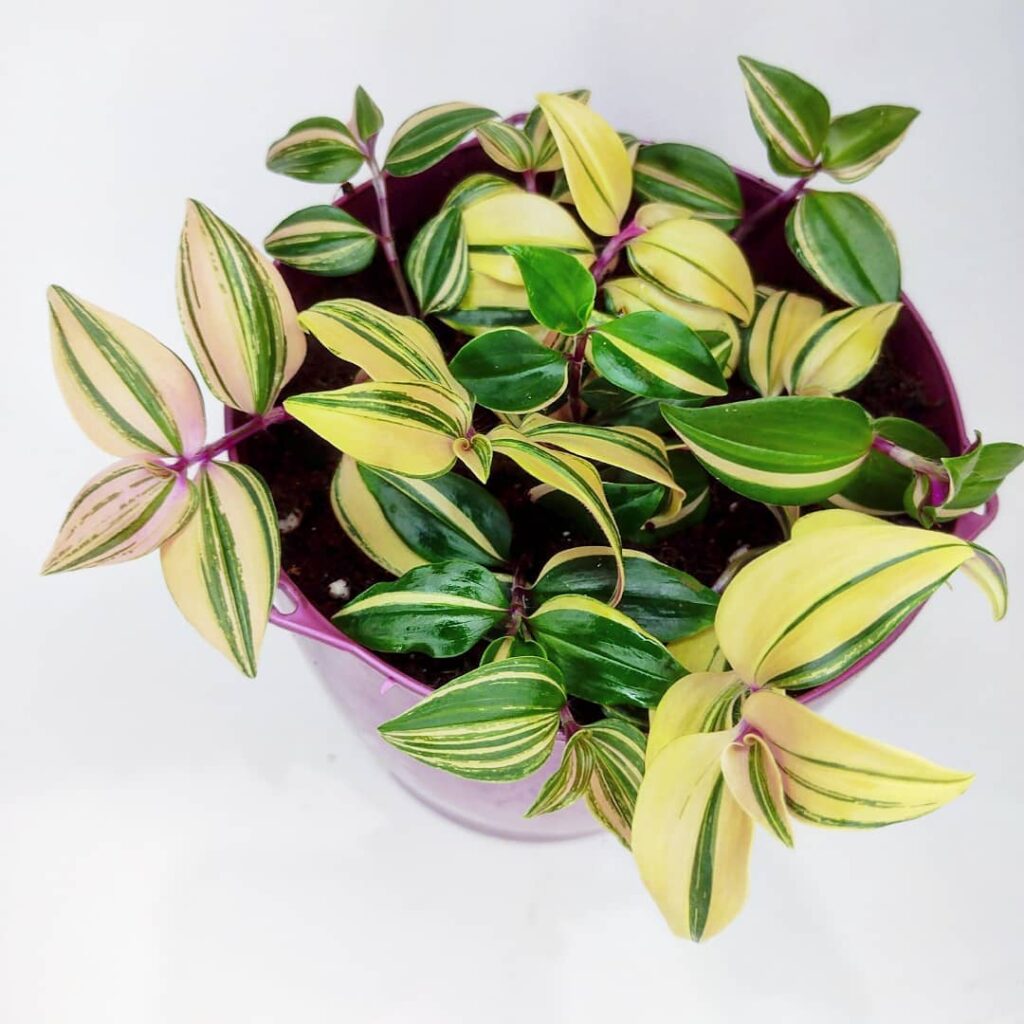
With cream, green, and pink-streaked leaves, Tradescantia Mundula ‘Variegata’ is an easy-care trailing plant that brightens indoor spaces.
Tradescantia Mundula ‘Green Hill’
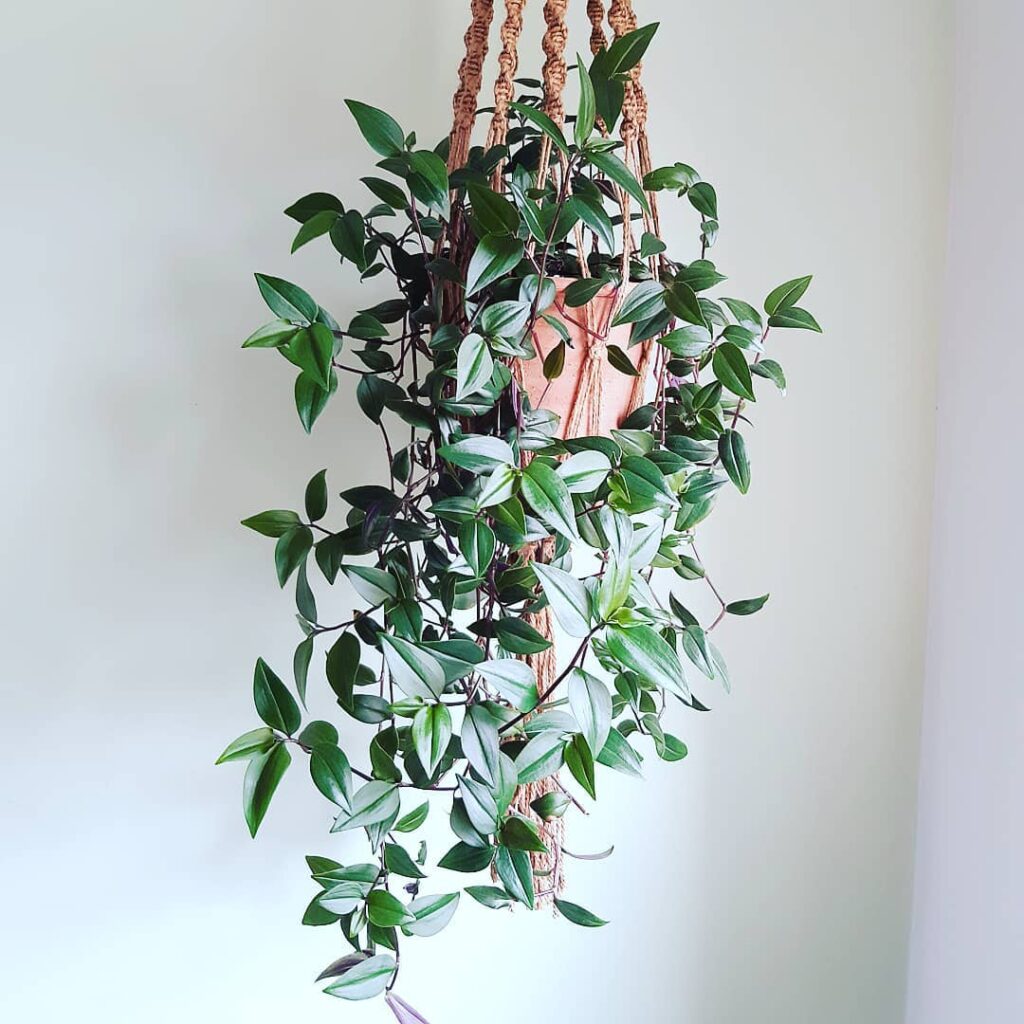
A lush and fast-growing variety, Tradescantia Mundula ‘Green Hill’ features small, pointed green leaves with a trailing habit. The foliage is dense and compact, making it an excellent choice for hanging baskets or ground cover. It thrives in bright, indirect light and prefers moderate watering, ensuring its vibrant green tones remain rich and healthy.
Tradescantia Mundula ‘Fairy Wings’

A delicate and compact cultivar, Tradescantia Mundula ‘Fairy Wings’ is one of the smallest Tradescantia varieties, yet it boasts incredible charm. Its tiny, almost invisible hairs distinguish it from Tradescantia Fluminensis, a key trait of the Mundula species. The variegation sets it apart from Mundula Lisa, though both varieties have the potential to revert to Green Hill.
Tradescantia Mundula ‘Lisa’
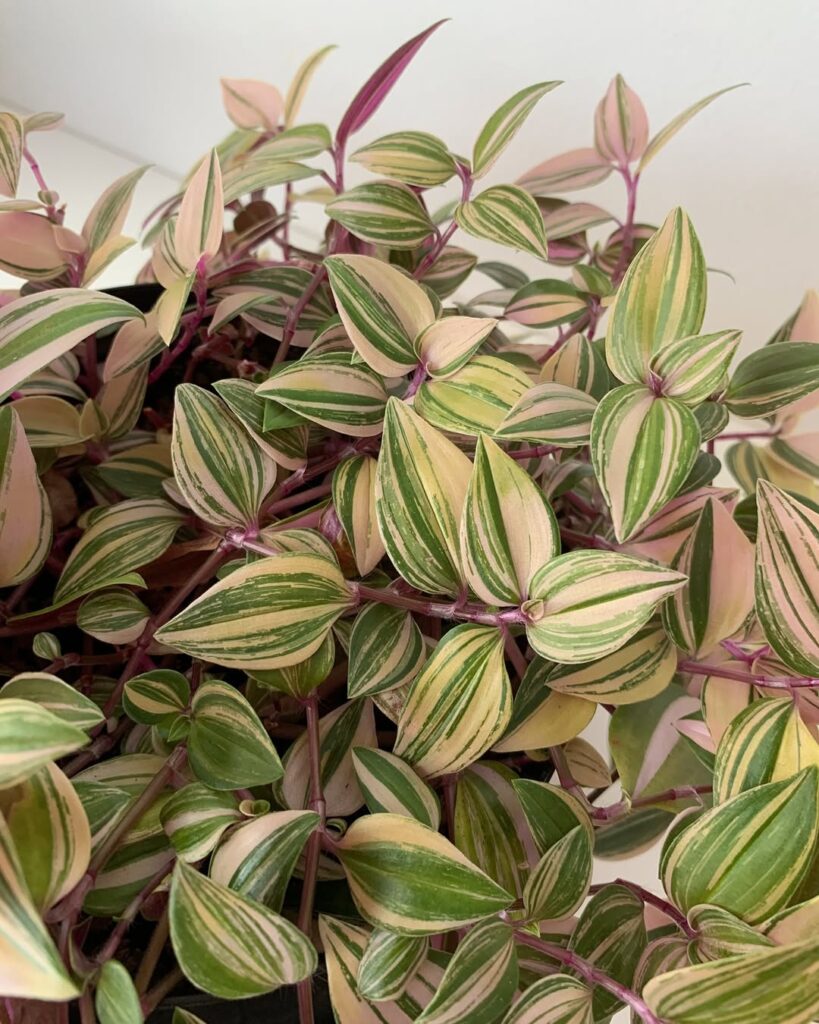
Tradescantia Mundula ‘Lisa’ is one of the most common variegated Tradescantia varieties after Nanouk, known for its green, cream, and pink-striped leaves. It has been sold under various names, including Tricolor, Quadricolor, Laekenensis, and Rainbow, but its official name is Lisa. Though often mislabeled as Fluminensis or Albiflora, Lisa belongs to the Mundula species, which can be distinguished by the tiny hairs on its stems and leaves—a trait absent in Fluminensis, which has smooth foliage.
Tradescantia Pink Dragon
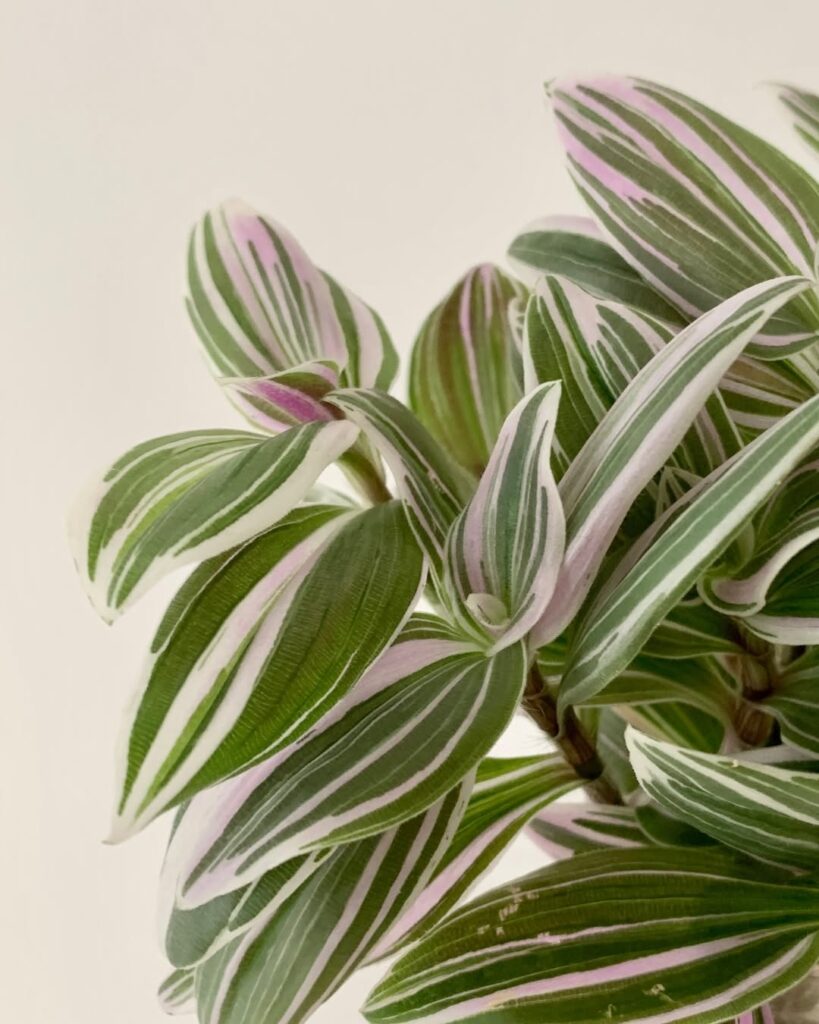
A fascinating member of the Continental Group, Tradescantia Pink Dragon is believed to be a hybrid of unknown origin. Like most others in this group, it has a compact growth habit and branches out easily, making it an excellent choice for dense foliage displays. Its slightly asymmetric leaves have rounded edges and are covered in small hairs, giving it a soft, textured appearance. This variety thrives in bright, indirect light and prefers moderate watering, ensuring its unique characteristics remain vibrant.
Tradescantia ‘Angel Wings’

A striking cultivar, Tradescantia ‘Angel Wings’ is a medium-sized variety with compact stems and pointed leaves featuring stable white and silvery-green variegation. Its elegant foliage pattern makes it a standout in any collection, thriving in bright, indirect light with moderate watering.
Tradescantia Roxxo
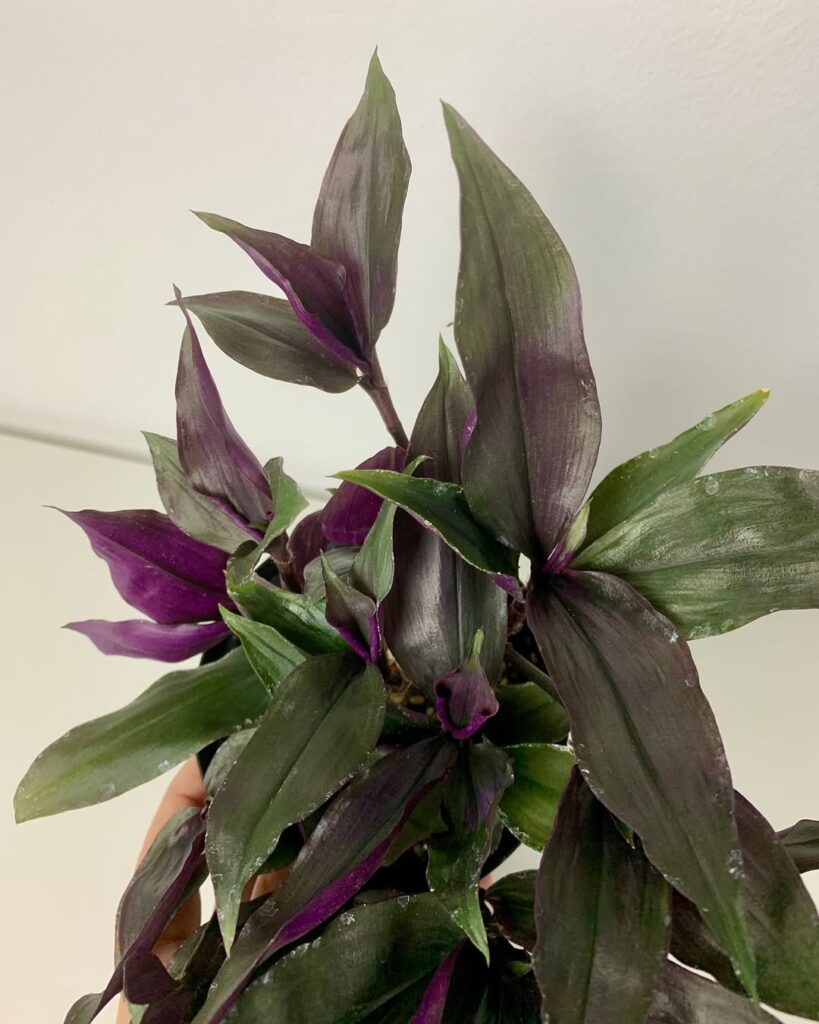
Also known as Tradescantia DRATRA01, Tradescantia Roxxo is a slow-growing cultivar with a more upright growth pattern and thicker, stronger stems than most other Tradescantias. When exposed to good light, its leaves develop a striking dark purple-red hue, making it a visually dramatic addition to any collection.
Tradescantia Hirta ‘Swifftale’
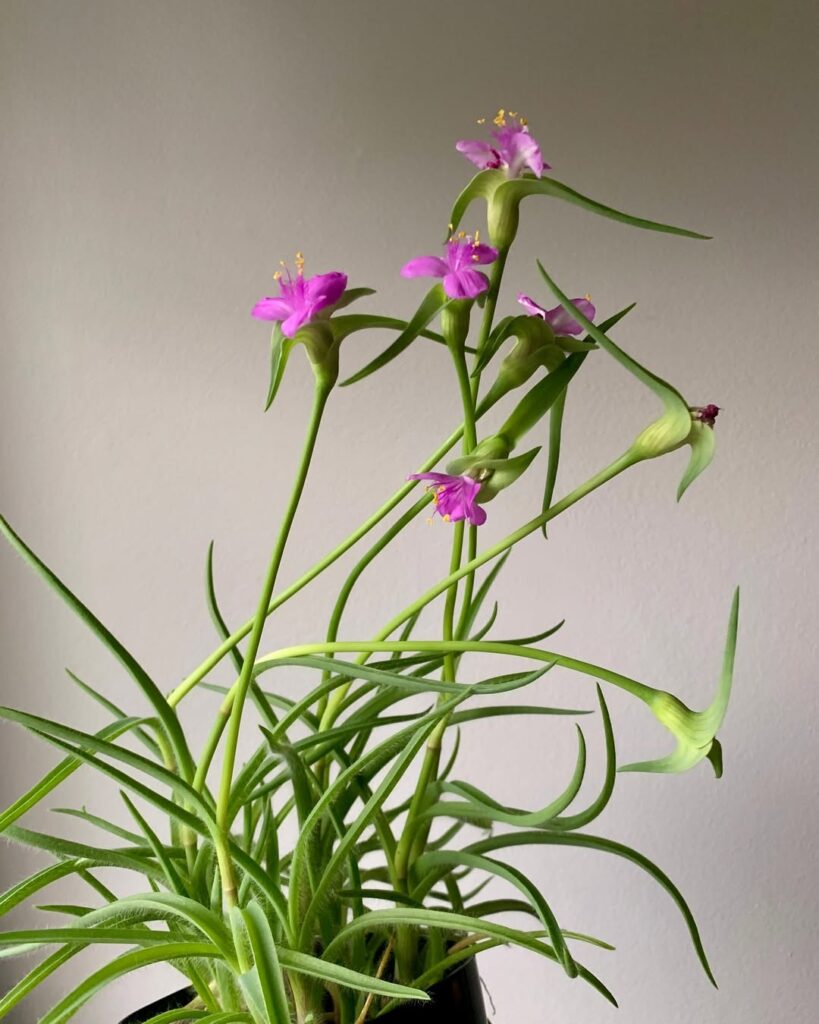
The only known cultivar of the Hirta species, Tradescantia Hirta ‘Swifftale’ has been around for about two decades. It features long, hairy, grass-like leaves and produces charming purple flowers with yellow stamens, which emerge at the tips of elongated stems. This rare variety is primarily found circulating in Europe, making it a prized addition for collectors.
Tradescantia Unicorn
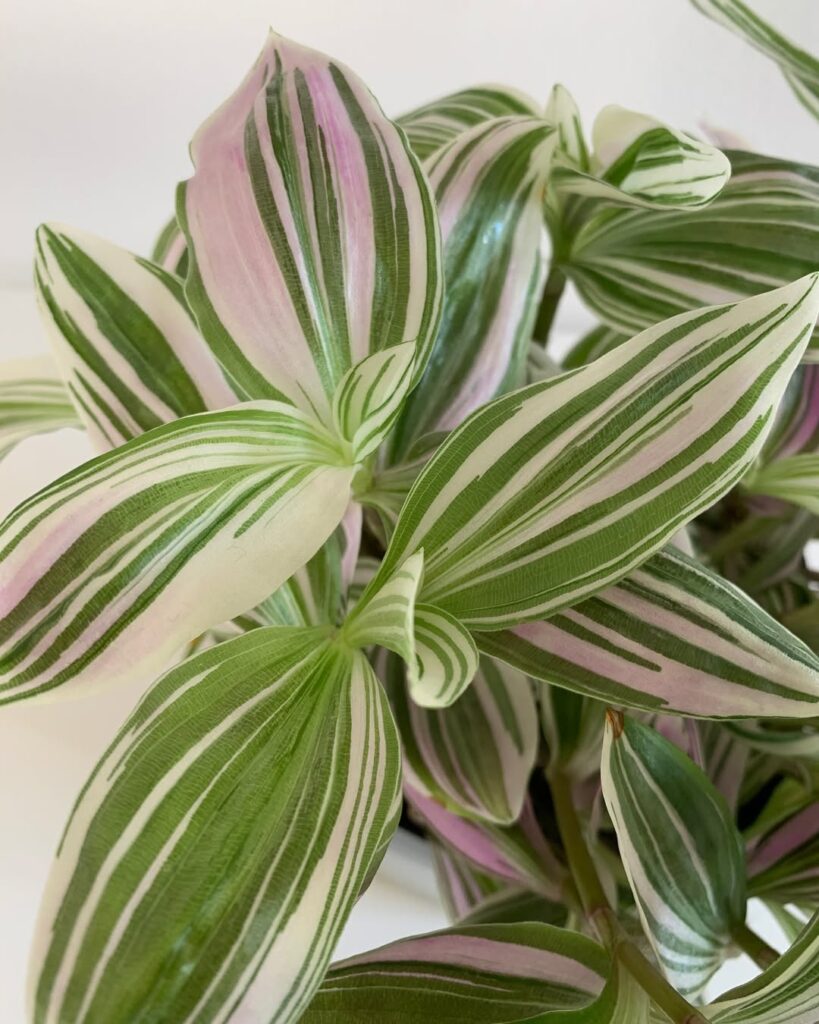
A charming variety within the Continental Group, Tradescantia ‘Unicorn’ boasts a compact growth habit with frequent branching. Its creamy pink and silvery-green variegation remains striking even when slightly pale, and some leaves occasionally develop an extra yellow stripe, adding to its unique appeal.
Tradescantia Tenderness
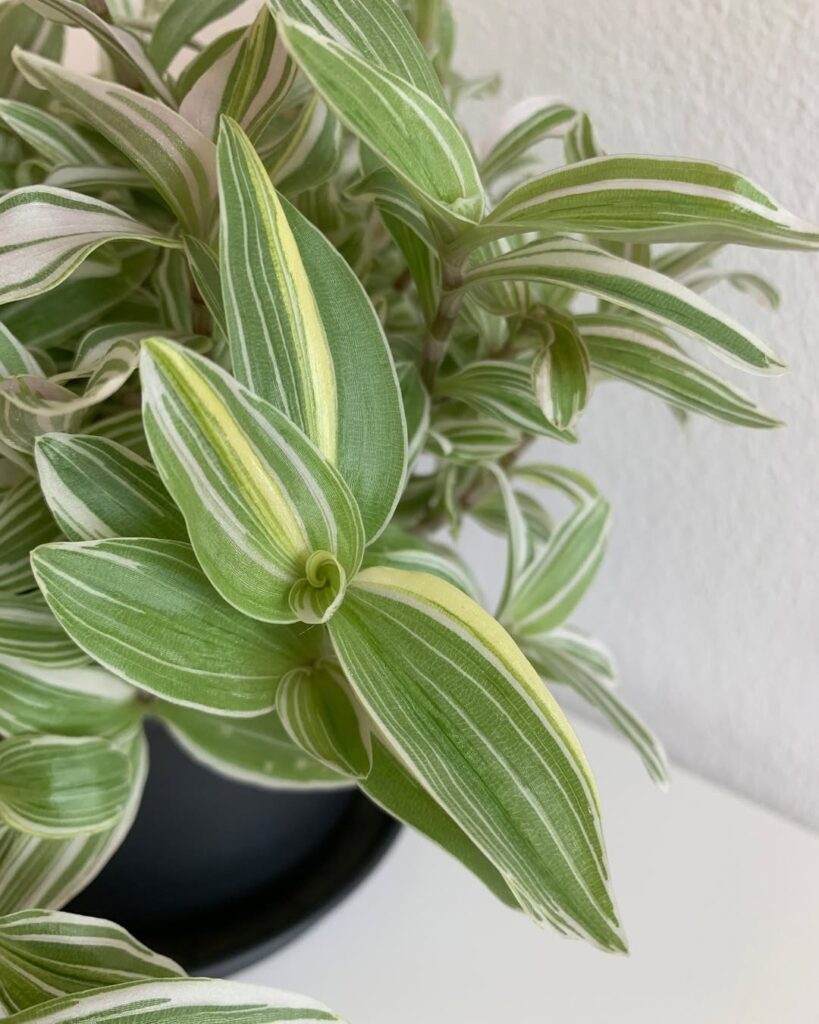
A distinctive cultivar, Tradescantia ‘Tenderness’ is known for its yellow stripes that randomly appear on the leaves, setting it apart from others in its group. It is often mistaken for Brightness, but Tenderness has longer, narrower leaves, while Brightness lacks the yellow striping.
Tradescantia Brightness
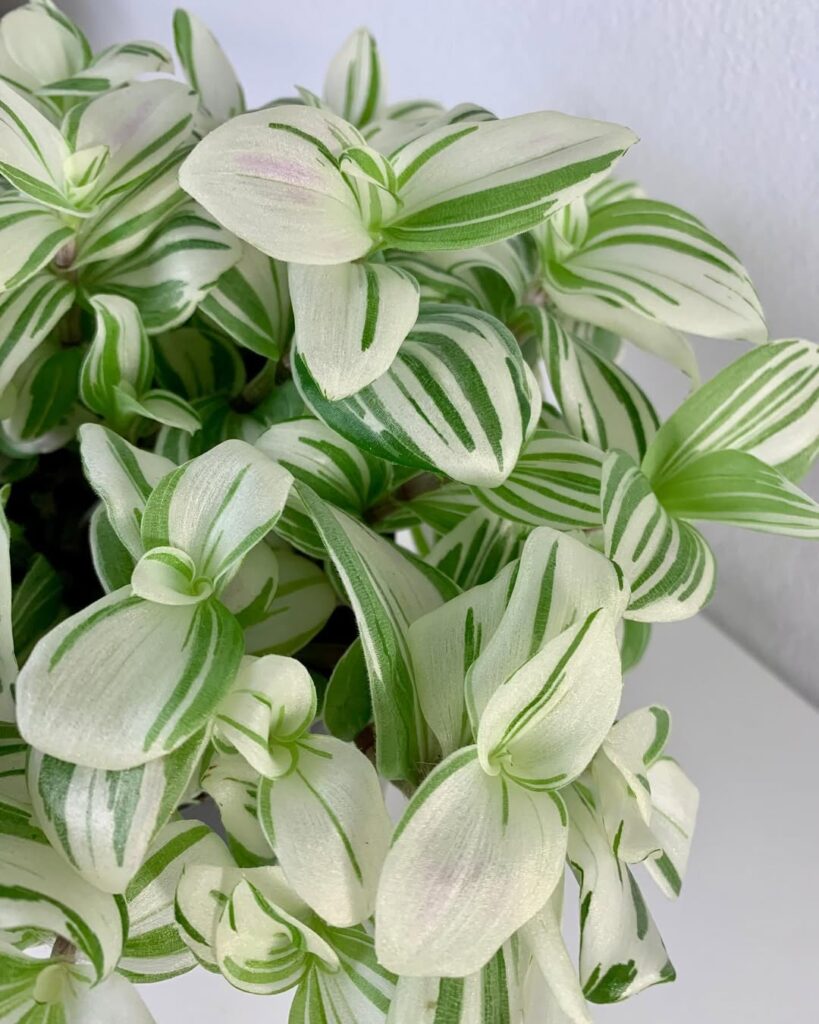
A stunning and increasingly popular cultivar, Tradescantia ‘Brightness’ is known for its white variegation, which can develop hints of pink under sufficient light. Its compact growth habit and vibrant foliage make it a standout among Tradescantia varieties, thriving best in bright, indirect light with moderate watering.
Tradescantia Pale Puma
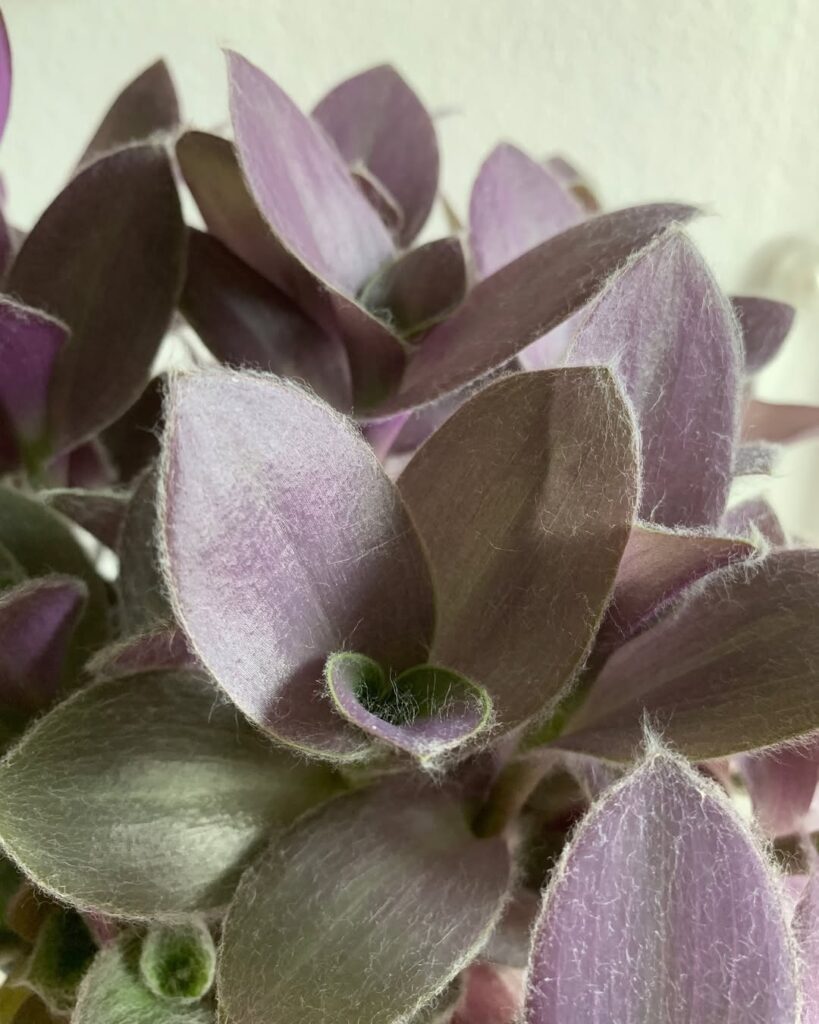
Tradescantia ‘Pale Puma’ is a mysterious cultivar with uncertain origins, often labeled as Pallida, Sillamontana, or a hybrid, though officially treated as an unknown species. Popular since the 1990s, it frequently forms flower buds that rarely open, but when they do, they reveal bright pink flowers. Its green leaves turn purple under strong light, making sunlight essential for vibrant coloration—indoors, the more light, the better, as it thrives under intense brightness.
Tradescantia Sweetness
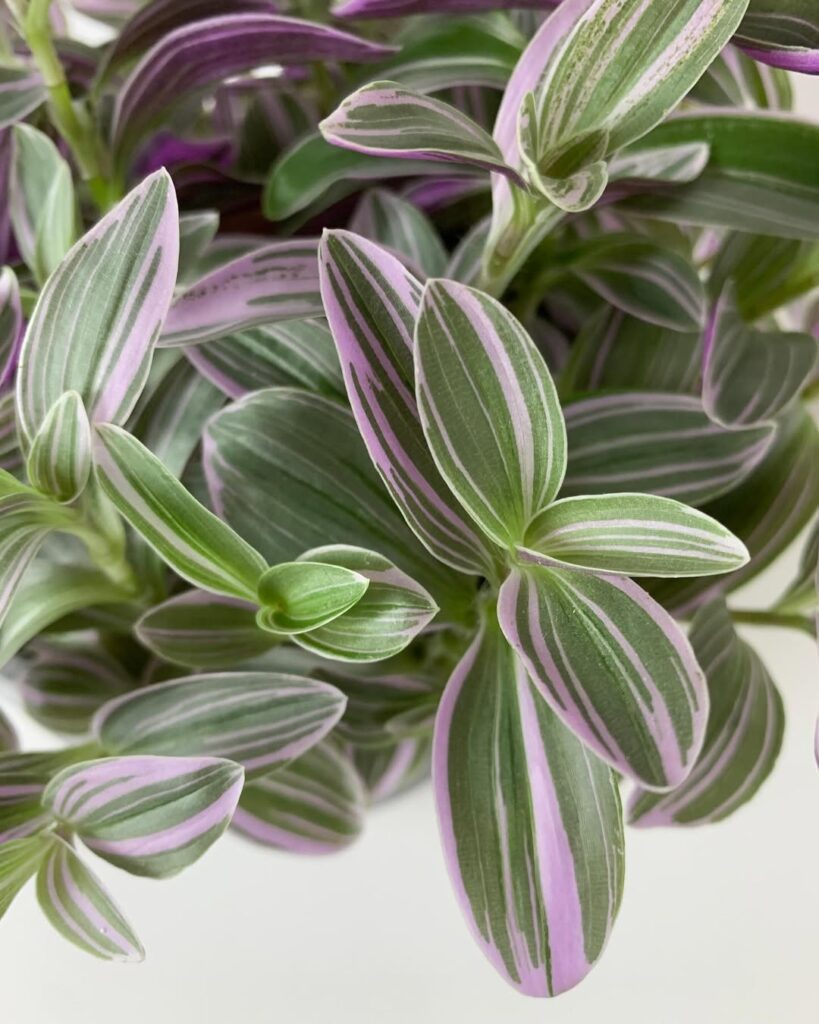
Tradescantia ‘Sweetness’, also known as EC-TRADE-2011 or Feeling Flirty, belongs to the Continental Group, a collection of Tradescantias with unknown origins. It has a compact growth habit, grows slowly, and features small, rounded leaves up to 5 cm long, striped in pale purple and yellow-green, with small white flowers. Often mistaken for Nanouk, it can be distinguished by its smaller leaves—if under 5-6 cm, it’s likely ‘Sweetness’; if larger, it’s Nanouk.
Tradescantia Sweet Tabby
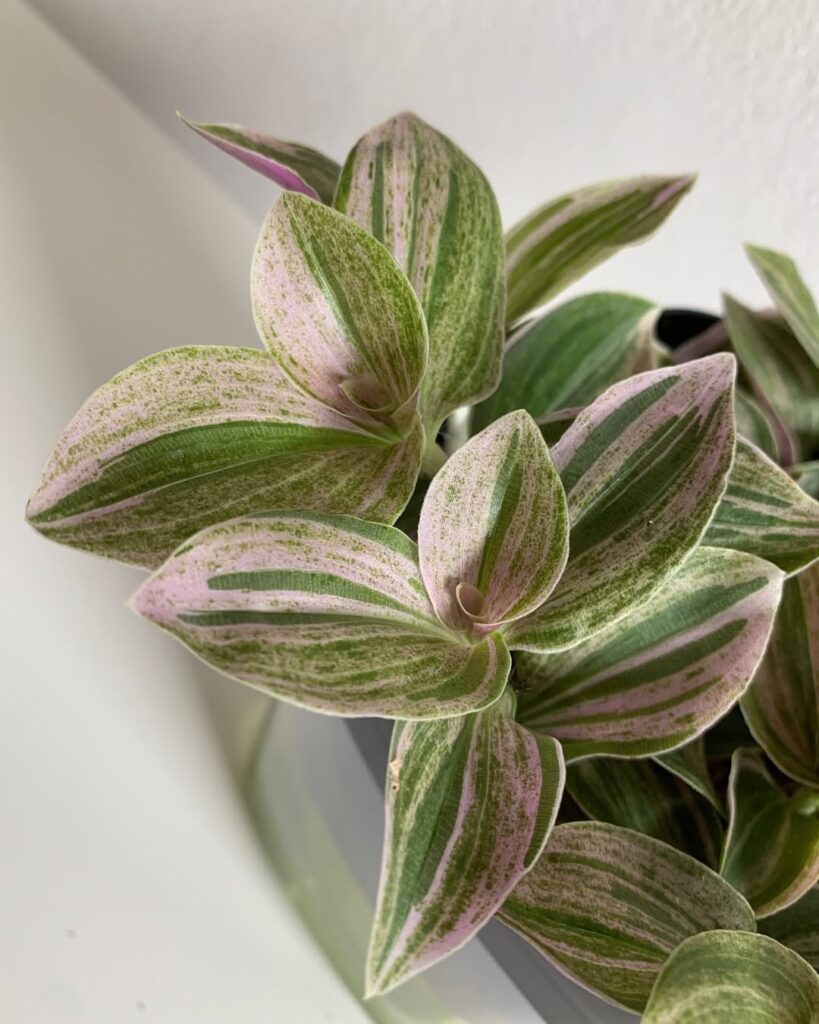
A sport of EC-TRADE-2011 (Sweetness), Tradescantia ‘Sweet Tabby’ is often mistaken for its parent cultivar but can be distinguished by its mottled stripes. It has a very compact growth habit, with heavily branching stems that tend to crawl along the surface, making it a low-growing variety.
Tradescantia Zanonia ‘Mexican Flag’
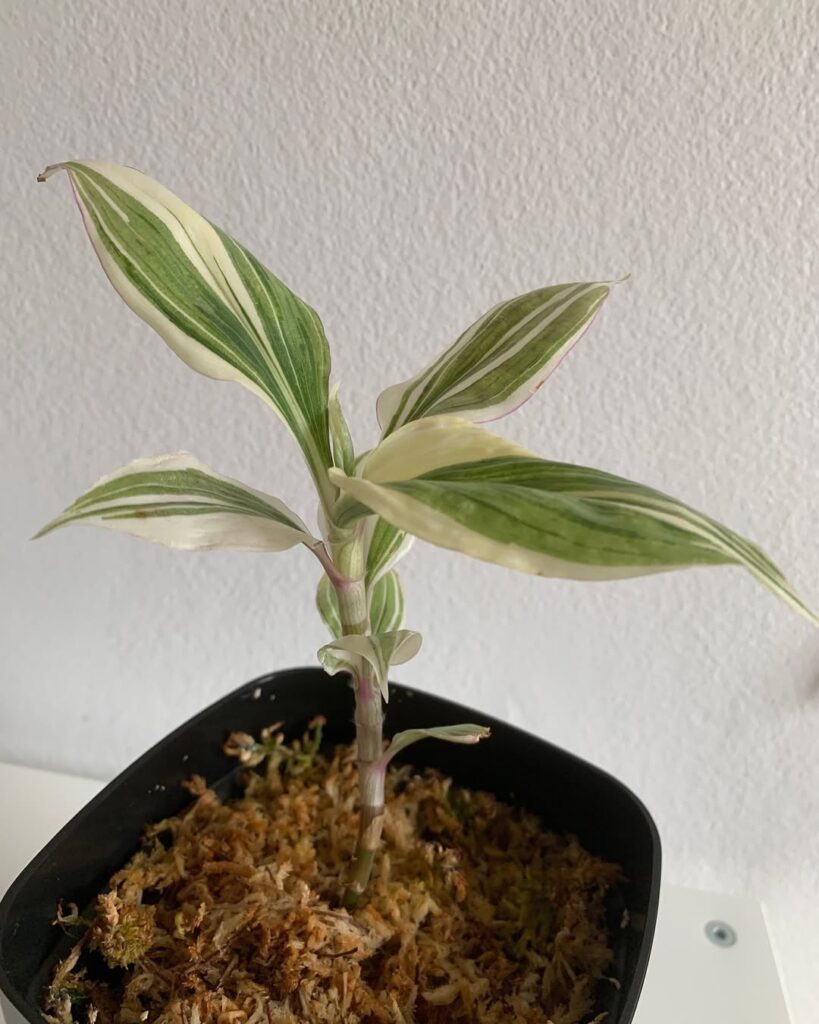
Also known by its botanical synonym Campelia Zanonia, Tradescantia Zanonia ‘Mexican Flag’ is the largest Tradescantia variety, with leaves reaching up to 20 cm long. It has an upright, thick, bamboo-like stem, allowing it to grow much taller than other Tradescantias, reaching up to 1.5 meters (about 5 feet). Its green leaves feature white variegation, and with enough light, the edges turn dark pink. When it blooms, it produces small white flowers, adding to its striking appearance
